This enchanting journey through Kyoto Prefecture begins with a breathtaking cable car ascent to Amanohashidate Viewland, where visitors can witness the legendary sandbar transform into a "Flying Dragon View" by peering through their legs. The adventure continues aboard the luxurious Tango Otohime Gozen dining train, offering a culinary exploration of local delicacies inspired by the Urashima Taro folktale, complete with scenic stops and a special temple seal. The day culminates in the timeless fishing village of Ine, where a boat tour among friendly seagulls provides unparalleled views of traditional funaya (boathouses), followed by tranquil moments at a waterfront coffee shop and a delicious seafood dinner overlooking the bay.
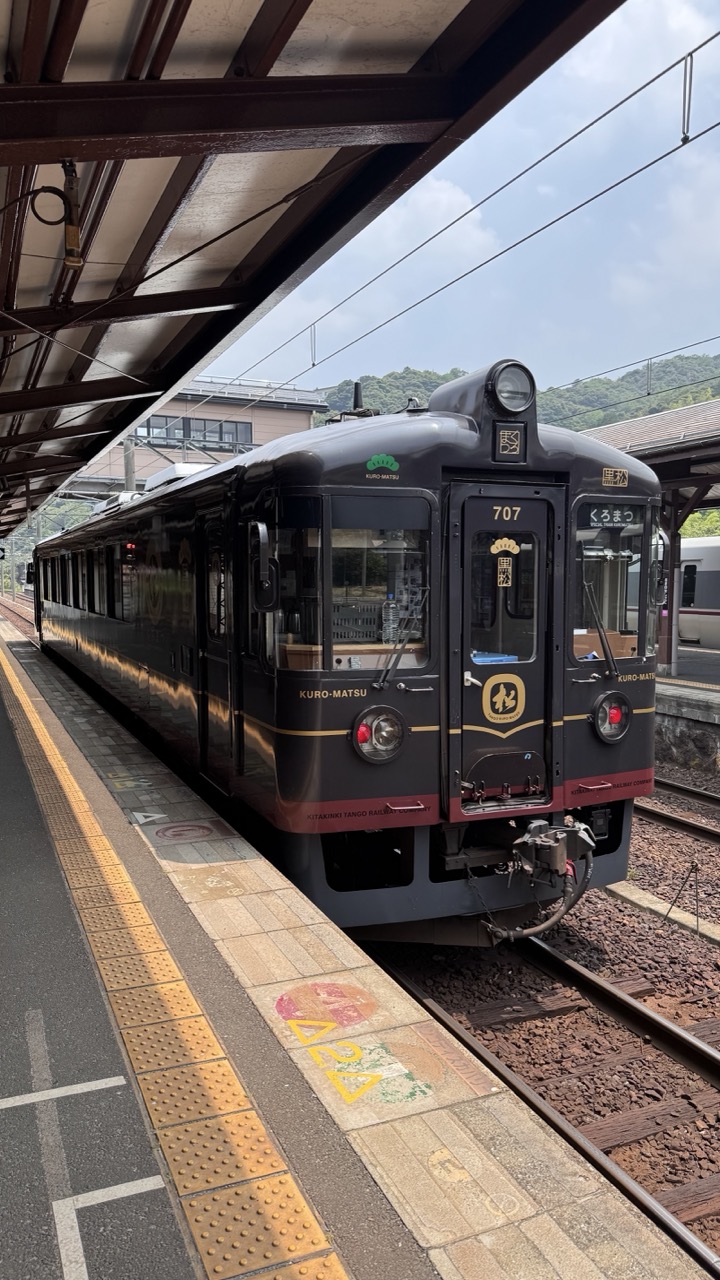

1. Overall Rating (0–10) — 7.0
This photograph captures the quiet dignity of a regional train at a rural station, where the interplay of industrial design and natural backdrop creates a sense of gentle motion and stillness. The dark, polished livery of the Kuro-Matsu train contrasts beautifully with the soft daylight and verdant hills beyond, giving the scene a timeless, almost cinematic quality. While the composition is strong, the slightly cluttered platform and overhead structure detract from the train’s elegance, preventing the image from achieving full visual harmony.
2. Composition (0–10) — 6.5
The train is framed diagonally, leading the eye from the foreground toward the background, creating a sense of depth. However, the overhanging roof and platform edges slightly disrupt the visual flow, and the train’s placement is slightly off-center, weakening balance.
3. Lighting (0–10) — 7.0
Natural daylight illuminates the scene evenly, with soft shadows that accentuate the train’s curves and reflective surfaces. The light enhances the metallic sheen of the train’s body and highlights the texture of the platform tiles, creating a balanced exposure.
4. Color & Tone (0–10) — 7.0
The deep black and gold of the train stand out against the muted tones of the platform and the pale blue sky. The natural color palette is restrained yet effective, with a subtle warmth that enhances the scene’s calm, contemplative mood.
5. Creativity (0–10) — 7.5
The image captures a moment of quiet travel with a sense of place and character, emphasizing the unique design of the Kuro-Matsu train. The juxtaposition of the man-made vehicle with the lush landscape adds narrative depth, suggesting a journey through both space and time.
6. Technical Quality (0–10) — 8.0
Sharp focus and clear detail are evident throughout, particularly on the train’s front and signage. The image is well-exposed, with no visible noise or distortion, indicating strong technical execution.
7. Emotional Impact (0–10) — 7.0
There is a sense of nostalgia and peaceful anticipation in the image—the train waiting, ready to carry passengers through a scenic landscape. The viewer is invited to imagine the journey ahead, evoking a quiet longing for travel and discovery.


1. Overall Rating (0–10) — 7.0
This photograph captures a moment of quiet dignity at a Japanese train station, where the polished tradition of service meets the rhythm of modern travel. The contrast between the formal bowing staff and the casually dressed passengers creates a subtle narrative of cultural ritual in motion. While the scene is rich in context, the composition's looseness and lack of strong focal tension keep it from feeling fully cinematic.
2. Composition (0–10) — 6.0
The diagonal alignment of the train and platform edge guides the eye, but the framing feels slightly unbalanced, with too much empty space on the left and a crowded foreground on the right. The two bowing staff members are well-placed, but the distant couple on the left distracts from the central action.
3. Lighting (0–10) — 6.5
Natural daylight illuminates the scene evenly, with soft shadows suggesting an overcast or late afternoon sky. The light enhances the reflective surface of the train and the yellow tactile paving, but lacks dramatic contrast or direction to elevate the mood.
4. Color & Tone (0–10) — 6.0
The palette is restrained—dominated by the black and gold of the train, the gray platform, and muted tones of the passengers’ clothing. The yellow tactile strip provides a pop of color, but the overall tone is slightly flat and lacks vibrancy.
5. Creativity (0–10) — 7.0
The image captures a culturally specific moment—bowing as a form of greeting or apology—offering a glimpse into Japanese etiquette. The juxtaposition of tradition and contemporary travel gives it narrative depth, though the execution remains observational rather than interpretive.
6. Technical Quality (0–10) — 7.5
The image is sharp and well-focused, with clean details in the train’s lettering and the platform’s textures. The exposure is balanced, and the camera appears to have captured the scene without noticeable noise or distortion.
7. Emotional Impact (0–10) — 6.5
The act of bowing evokes a sense of respect and humility, creating a quiet emotional resonance. However, the lack of close-up intimacy and the distance of the viewer from the subjects prevent a deeper emotional connection.
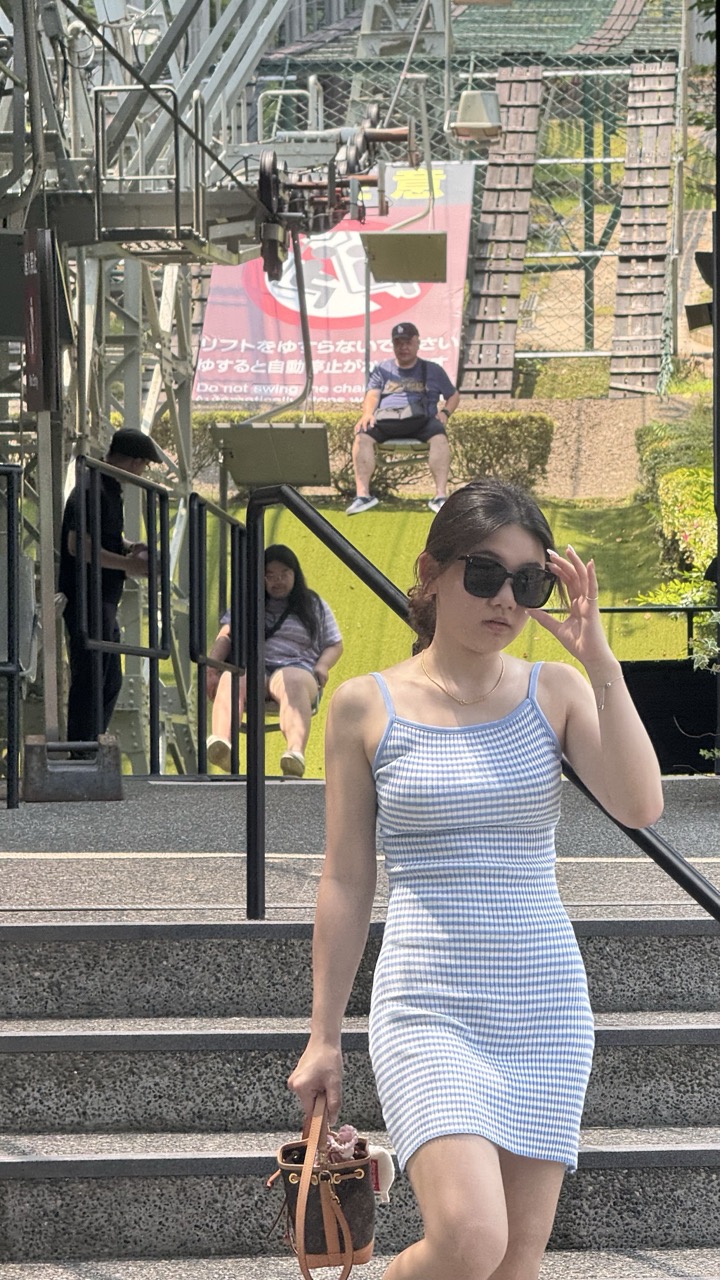

1. Overall Rating (0–10) — 6.0
This photograph captures a candid moment at an amusement park, where the subject’s poised demeanor contrasts with the bustling, chaotic environment behind her. The composition draws attention to the woman in the foreground, but the background clutter and uneven framing dilute the image’s visual impact. While the scene feels authentic and relatable, the lack of compositional harmony and overexposure in highlights prevent it from feeling fully cohesive or artistically refined.
2. Composition (0–10) — 5.0
The subject is placed off-center, creating a dynamic but unbalanced frame. The foreground steps lead the eye into the scene, but the distracting background elements—especially the cables, signage, and people—compete for attention and disrupt the focus.
3. Lighting (0–10) — 5.5
Harsh midday sunlight creates strong shadows and blown-out highlights, particularly on the woman’s face and the background. While the lighting is bright and clear, it lacks subtlety and fails to enhance the mood or texture of the scene.
4. Color & Tone (0–10) — 6.0
The blue and white gingham dress stands out against the muted, green-and-gray backdrop, creating a pleasing contrast. However, the color palette is somewhat flat, with oversaturated greens and a lack of tonal depth, giving the image a slightly dated, over-processed feel.
5. Creativity (0–10) — 5.5
The image relies on a common tourist photography trope—posing at an amusement park—without adding narrative depth or visual originality. The juxtaposition of the subject’s cool confidence against the functional, slightly chaotic setting offers a subtle story, but it remains underdeveloped.
6. Technical Quality (0–10) — 7.0
The focus is sharp on the woman, and the image is free of major technical flaws like motion blur or noise. However, the overexposure in the sky and highlights suggests a lack of careful exposure control.
7. Emotional Impact (0–10) — 5.0
The photograph conveys a sense of casual confidence and summer spontaneity, but the emotional connection is limited by the cluttered environment and the subject’s detached expression. The viewer is left with a snapshot rather than a moment of genuine resonance.
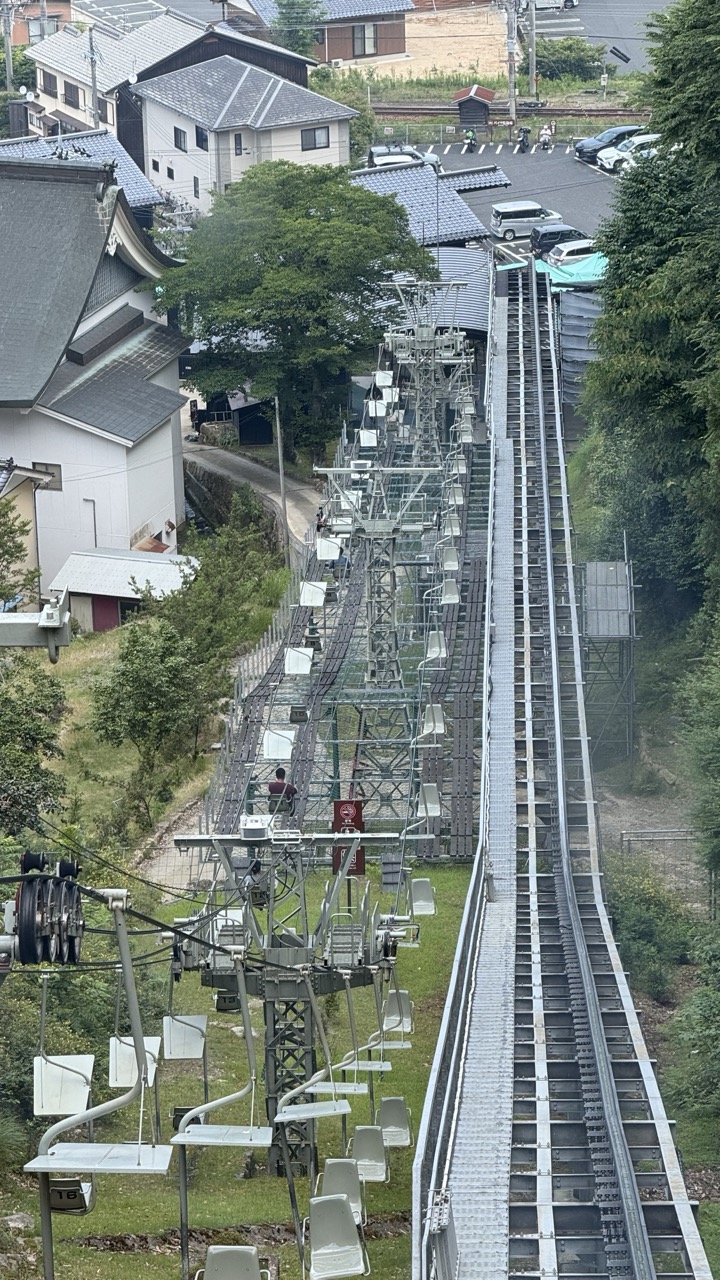

1. Overall Rating (0–10) — 7.0
This photograph captures the juxtaposition of traditional Japanese architecture and modern transportation infrastructure, creating a compelling narrative of coexistence. The upward angle of the cable car tracks draws the eye through the frame, emphasizing movement and elevation, while the surrounding greenery softens the industrial elements. While the composition is visually engaging, the lack of human presence or focal point slightly diminishes its emotional pull.
2. Composition (0–10) — 7.5
The diagonal lines of the cable car tracks guide the viewer’s gaze from the foreground to the background, creating a sense of depth. The placement of the buildings and trees on either side frames the central structure, balancing the composition. However, the inclusion of too many elements in the upper right—cars, rail lines, and signage—introduces visual clutter that detracts from the overall harmony.
3. Lighting (0–10) — 6.5
The overcast sky provides soft, even lighting that minimizes harsh shadows and allows for clear detail across the scene. While the lighting is functional and consistent, it lacks dramatic contrast or warmth, resulting in a somewhat flat and neutral atmosphere.
4. Color & Tone (0–10) — 6.0
The palette is dominated by muted grays and greens, reflecting the overcast conditions and the industrial materials of the cable car structure. The traditional white and dark-tiled roofs provide subtle contrast, but the overall tone is subdued, with little vibrancy or dynamic color range.
5. Creativity (0–10) — 7.0
The image successfully captures a unique intersection of culture and technology, offering a fresh perspective on a familiar urban landscape. The choice to photograph from above the cable car system adds a sense of scale and motion, elevating it beyond a simple snapshot.
6. Technical Quality (0–10) — 7.5
The image is sharp and detailed, with clear focus across the frame. The depth of field is sufficient to render both the foreground and background with clarity, and there are no visible technical flaws such as blur or noise.
7. Emotional Impact (0–10) — 6.0
The photograph evokes a sense of quiet observation and curiosity about the daily rhythm of life in this locale. While it presents an interesting visual narrative, the absence of people or a strong emotional anchor keeps the viewer at a distance, preventing a deeper emotional connection.
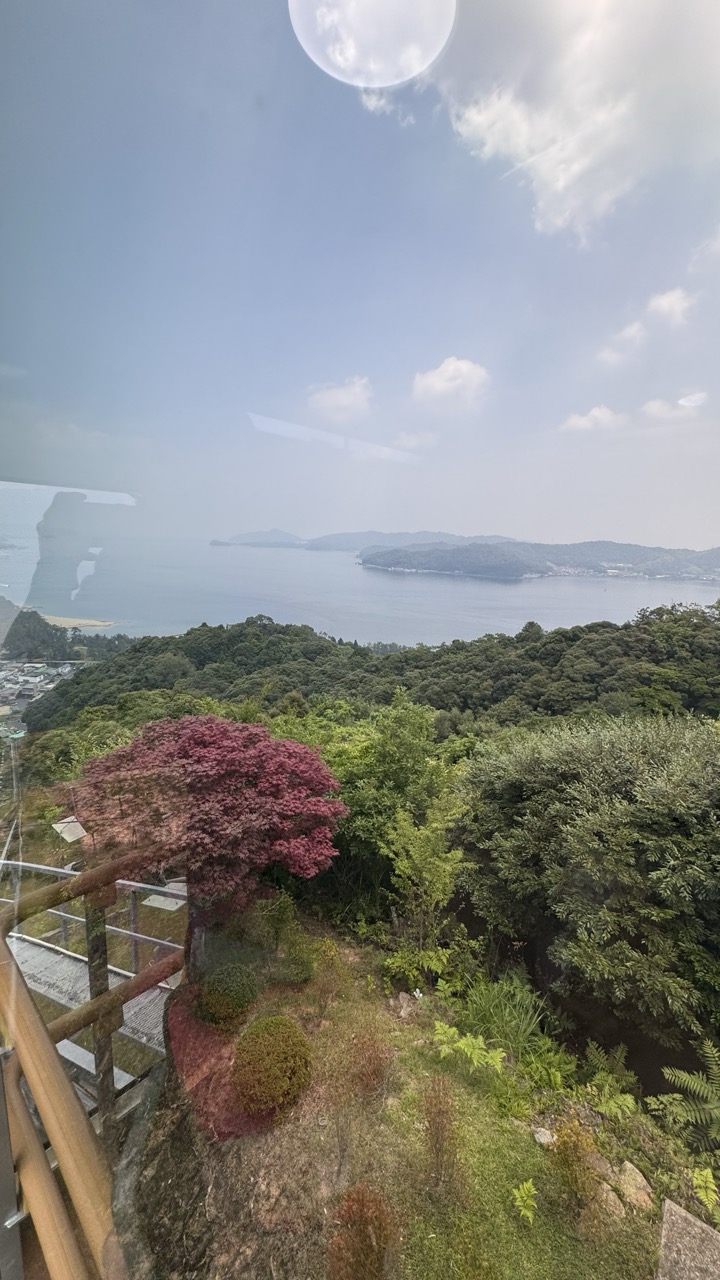

1. Overall Rating (0–10) — 6.0
This photograph captures a serene coastal vista, where the lush greenery and distant islands evoke a sense of peaceful isolation. The vivid magenta tree provides a striking focal point, drawing the eye through the layered landscape, though the visible reflection and hazy atmosphere slightly diminish its visual clarity. While the scene is inherently picturesque, the image feels more like a candid snapshot than a composed photograph, lacking the refinement to fully convey its natural beauty.
2. Composition (0–10) — 6.5
The diagonal railing and the magenta tree create a dynamic leading line, guiding the viewer toward the expansive sea and islands. However, the reflection in the glass disrupts the visual flow and introduces a distracting element, weakening the overall balance.
3. Lighting (0–10) — 6.0
Soft, diffused daylight enhances the tranquil mood, but the overcast sky and haze reduce contrast and depth. The bright circular reflection in the upper center competes with the natural light, further muddying the tonal harmony.
4. Color & Tone (0–10) — 6.5
The palette blends earthy greens with the bold magenta of the tree, creating a pleasing contrast. However, the overall tone is somewhat washed out due to atmospheric haze and the muted sky, preventing the colors from feeling vibrant or saturated.
5. Creativity (0–10) — 6.0
The inclusion of the reflective glass adds an unexpected layer of depth, suggesting the viewer is observing the scene from behind a barrier—perhaps a window or observation deck. This framing introduces a narrative element, but it remains underdeveloped, making the image feel more observational than imaginative.
6. Technical Quality (0–10) — 6.0
The image is reasonably sharp, with clear details in the foliage and railing. However, the presence of the reflection and slight haze reduces overall clarity and diminishes the impact of the composition.
7. Emotional Impact (0–10) — 6.5
The photograph evokes a quiet contemplation of nature and distance, with the vast sea and rolling hills suggesting a sense of calm and introspection. While the emotional resonance is present, the technical imperfections keep the viewer from fully immersing in the scene.
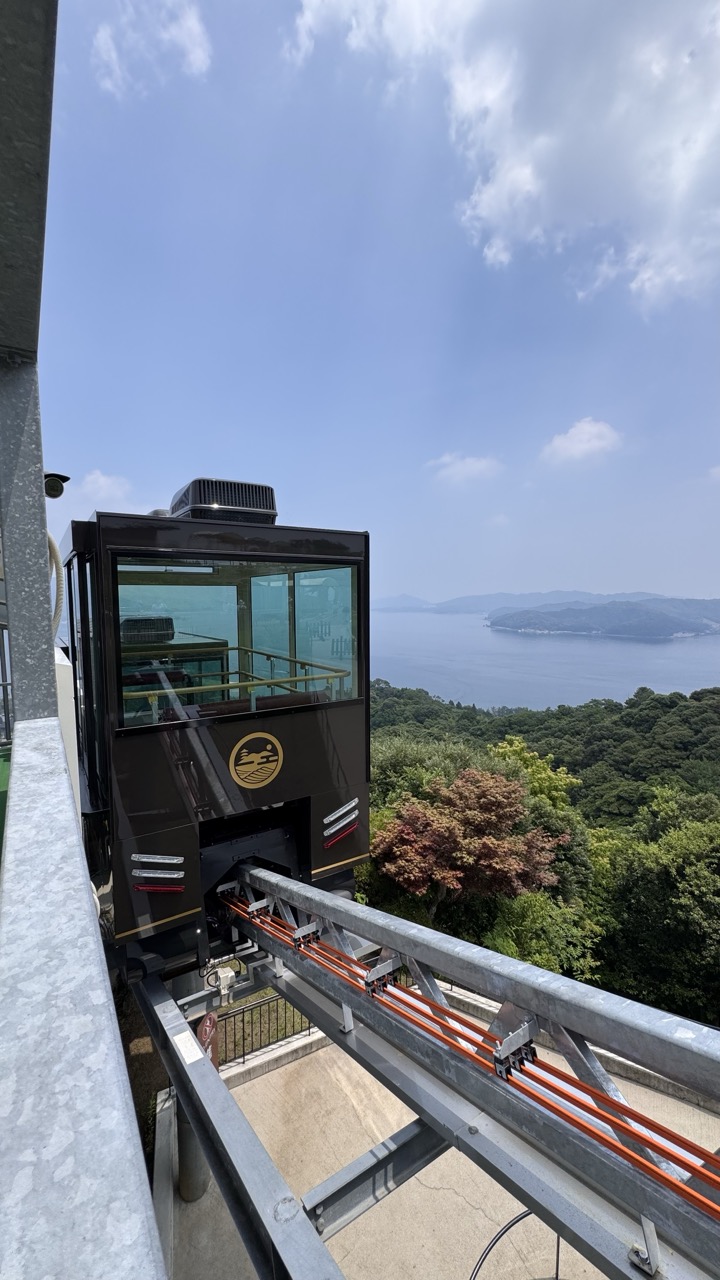

1. Overall Rating (0–10) — 7.5
This photograph captures a striking juxtaposition of industrial design and natural grandeur, with a cable car poised against a sweeping vista of sea and forested hills. The composition draws the eye from the mechanical foreground into the expansive landscape, evoking a sense of motion and connection between human engineering and the environment. While the image is visually compelling, its slightly overexposed sky and lack of a strong focal point slightly diminish its emotional resonance.
2. Composition (0–10) — 7.0
The cable car is placed off-center, creating a dynamic diagonal line that guides the viewer’s gaze toward the distant sea. The inclusion of the track in the foreground adds depth, though the left-side framing feels slightly unbalanced.
3. Lighting (0–10) — 7.5
Bright, natural daylight enhances clarity and detail throughout the scene. The sky is slightly overexposed, but the overall lighting supports a crisp, open atmosphere that highlights the lush greenery and the calm water.
4. Color & Tone (0–10) — 7.0
The palette is dominated by cool blues and vibrant greens, creating a refreshing contrast with the dark tones of the cable car. The warm orange of the track adds a subtle accent, enhancing visual interest without disrupting harmony.
5. Creativity (0–10) — 7.5
The image successfully blends technology and nature, offering a unique perspective that emphasizes both human ingenuity and the beauty of the landscape. The angle and framing suggest intentionality, elevating the scene beyond a simple travel snapshot.
6. Technical Quality (0–10) — 8.0
The image is sharp and well-focused, with clear details in the cable car, track, and foliage. The exposure is largely balanced, with only minor overexposure in the sky.
7. Emotional Impact (0–10) — 7.0
The photograph evokes a sense of adventure and tranquility, inviting the viewer to imagine the journey and the view beyond. The expansive vista inspires awe, though the emotional pull is tempered by the image’s documentary tone.
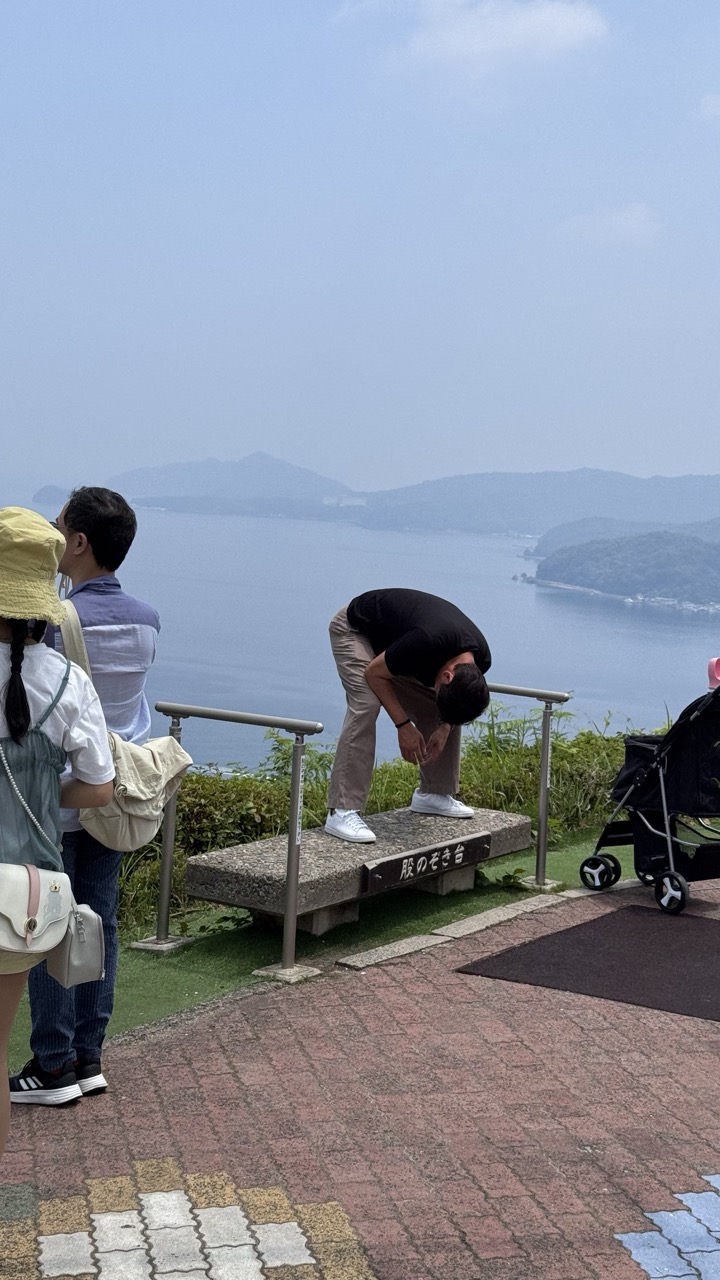

1. Overall Rating (0–10) — 6.0
This photograph captures a candid moment at a scenic viewpoint, where a man’s bowing gesture stands in quiet contrast to the expansive, hazy seascape behind him. The image conveys a subtle cultural nuance—perhaps a respectful greeting or a moment of gratitude—yet its emotional resonance is muted by a lack of visual focus and atmospheric depth. While the setting is serene and the gesture meaningful, the composition feels slightly cluttered and the lighting flattens the scene, preventing it from achieving a more evocative presence.
2. Composition (0–10) — 5.5
The subject is placed off-center, with the man bending over a stone platform, creating a dynamic focal point. However, the foreground elements—such as the stroller and scattered visitors—compete for attention, diluting the visual narrative. The wide framing includes too much empty sky and background, weakening the impact of the central action.
3. Lighting (0–10) — 5.0
The scene is illuminated by soft, diffused daylight, likely from an overcast or hazy sky, which results in low contrast and a washed-out appearance. While the lighting is even and avoids harsh shadows, it lacks the richness needed to accentuate texture or mood, giving the image a flat, documentary feel.
4. Color & Tone (0–10) — 5.5
The palette is dominated by muted blues and grays, with the green of the railing and foliage offering a subtle contrast. The tones are subdued, reflecting the hazy atmosphere, but the lack of vibrancy limits the image’s visual appeal. The color temperature is cool, reinforcing the calm but distant mood.
5. Creativity (0–10) — 6.5
The photograph captures a culturally specific gesture in a natural setting, offering a narrative about respect and place. The juxtaposition of the man’s bow against the panoramic view introduces a quiet storytelling element. While the concept is thoughtful, the execution lacks refinement, and the image remains more observational than artistically expressive.
6. Technical Quality (0–10) — 7.0
The image is sharp and well-focused, with clear detail in the foreground and background. The exposure is balanced, and there are no major technical flaws. However, the lack of depth and contrast limits the overall visual impact.
7. Emotional Impact (0–10) — 5.0
The emotional weight of the moment—rooted in cultural respect—is present but understated. The viewer is left to interpret the gesture without strong visual cues or emotional amplification, resulting in a sense of distance rather than connection.
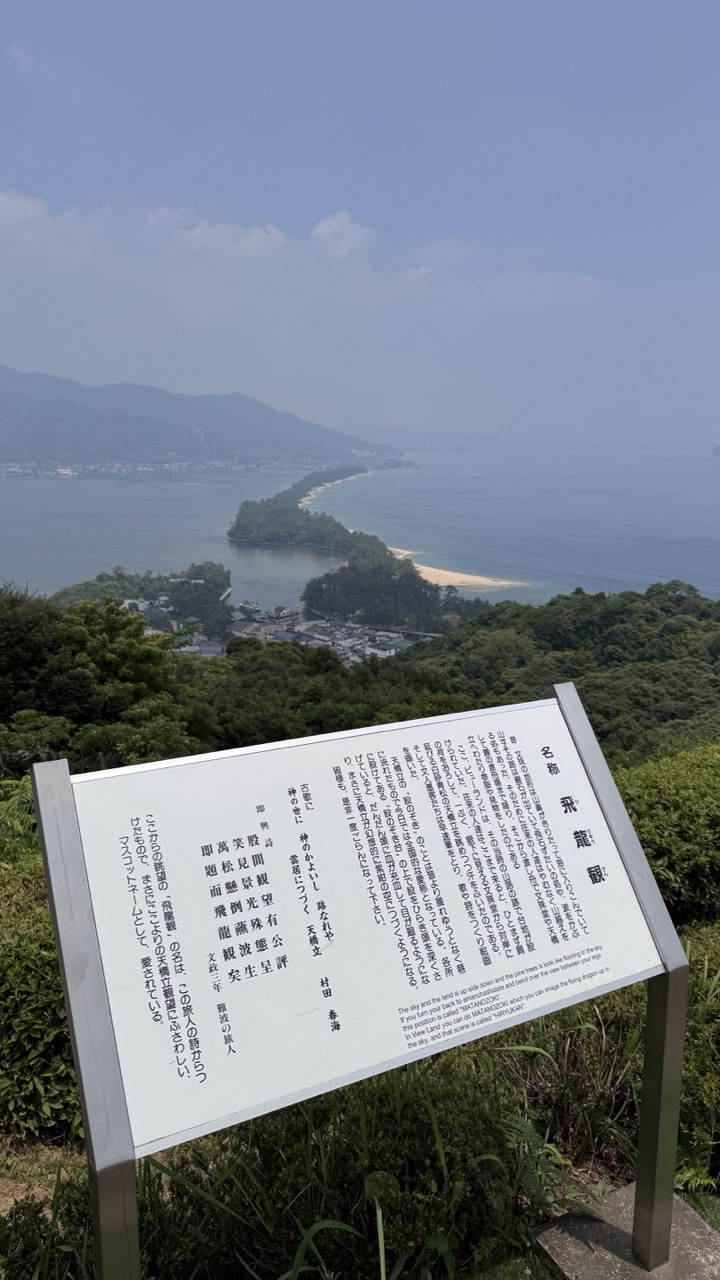

1. Overall Rating (0–10) — 6.0
This photograph captures a serene coastal vista from an elevated viewpoint, where the natural beauty of the landscape is framed by a cultural marker—a sign with Japanese text. The composition balances the informative foreground with the expansive background, suggesting a moment of pause and reflection. While the image successfully conveys the location’s tranquil atmosphere, the presence of the sign and its textual content slightly disrupts the visual harmony, creating a sense of documentary over artistic intent.
2. Composition (0–10) — 6.5
The sign occupies the lower-left foreground, drawing attention and anchoring the frame, while the expansive view of the bay, island, and distant mountains fills the background. The diagonal placement of the sign adds dynamic tension, but the composition feels slightly unbalanced due to the weight of the text and the lack of a clear focal point in the landscape.
3. Lighting (0–10) — 7.0
The scene is illuminated by soft, diffused daylight, likely from an overcast or hazy sky, which results in even lighting across the landscape. The light enhances the calm mood without creating harsh shadows, though it slightly mutes the vibrancy of the natural colors.
4. Color & Tone (0–10) — 6.0
The palette is dominated by muted greens, blues, and grays, reflecting the natural environment and atmospheric conditions. The white sign introduces a strong contrast, but its neutral tone blends into the overall subdued color scheme, limiting visual impact.
5. Creativity (0–10) — 6.0
The photograph combines a natural landscape with a cultural artifact, offering a layered interpretation of place and identity. While the concept is thoughtful, the execution leans toward the conventional, with little experimentation in perspective or framing.
6. Technical Quality (0–10) — 7.5
The image is sharp and well-focused, with clear details in both the sign and the distant scenery. The exposure is balanced, and the depth of field effectively captures both foreground and background elements.
7. Emotional Impact (0–10) — 6.5
The image evokes a sense of peaceful contemplation and connection to place, inviting the viewer to pause and reflect. The combination of nature and human presence creates a quiet emotional resonance, though the lack of personal or narrative depth limits its power to move.
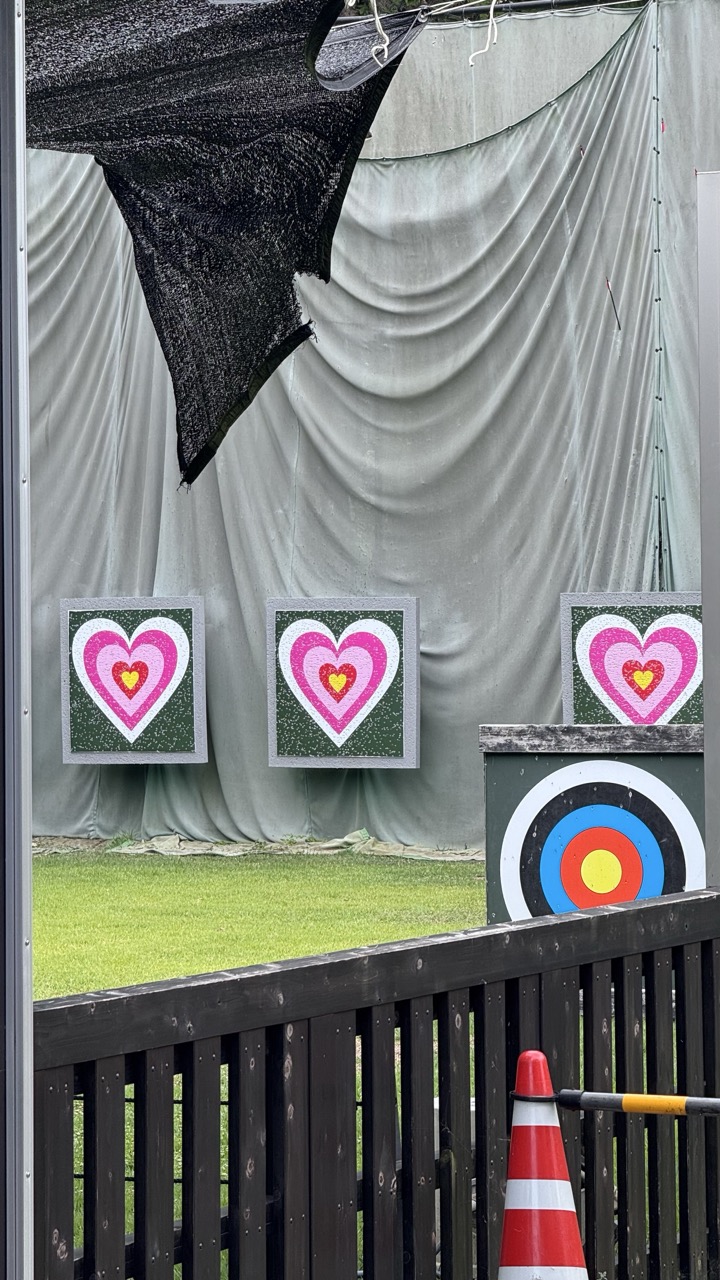

1. Overall Rating (0–10) — 6.0
This photograph captures a playful yet slightly disjointed scene at an archery range, where heart-shaped targets and a traditional bullseye coexist in a curious juxtaposition. The composition feels candid and unpolished, with a mix of bright, childlike colors against a muted, industrial backdrop. While the image conveys a sense of fun and accessibility, it lacks visual cohesion and fails to fully engage the viewer, feeling more like a snapshot than a deliberate artistic statement.
2. Composition (0–10) — 5.5
The framing is slightly off-center, with a cluttered foreground of a dark railing and a traffic cone that distract from the main subject. The three heart targets create a visual rhythm, but their arrangement feels unbalanced, and the inclusion of the standard archery target introduces a stylistic dissonance.
3. Lighting (0–10) — 6.0
Natural daylight illuminates the scene evenly, but the overcast conditions result in flat, diffused light that diminishes texture and depth. The black shade cloth in the upper left casts a subtle shadow, adding some visual interest but not enough to create dramatic contrast.
4. Color & Tone (0–10) — 6.5
The bright pinks and yellows of the heart targets stand out against the neutral green and gray tones of the background, creating a playful contrast. However, the overall color palette is restrained, with the muted tones of the fabric and wood slightly dulling the vibrancy of the subjects.
5. Creativity (0–10) — 6.0
The combination of whimsical heart targets with a standard archery setup suggests a playful, possibly family-friendly environment. The conceptual contrast between traditional and modern targets is intriguing, but the execution feels more incidental than intentional.
6. Technical Quality (0–10) — 7.0
The image is sharp and in focus, with clear details visible in the targets, the grass, and the railing. The camera appears to be at a steady distance, and there is no noticeable blur or noise.
7. Emotional Impact (0–10) — 5.5
The image evokes a sense of lightheartedness and accessibility, suggesting a fun, recreational space. However, the lack of human presence and the somewhat cluttered framing prevent a deeper emotional connection, leaving the scene feeling more observational than evocative.
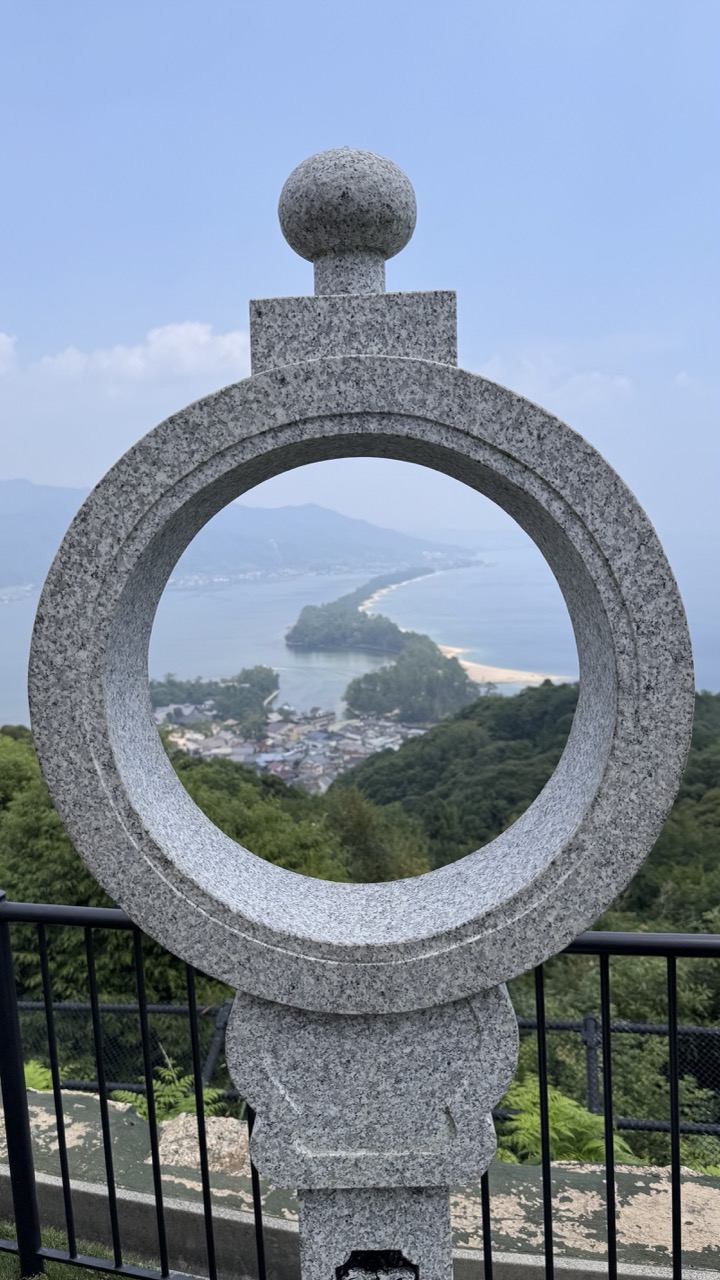

1. Overall Rating (0–10) — 7.5
This photograph masterfully uses a traditional stone ring as a natural frame, drawing the eye to a serene coastal landscape that unfolds beyond. The juxtaposition of the man-made structure with the organic sweep of the bay and forested hills creates a contemplative balance between culture and nature. While the image is visually striking and conceptually strong, its full emotional resonance is slightly tempered by a lack of atmospheric depth in the distant scenery.
2. Composition (0–10) — 8.0
The circular frame of the stone structure creates a strong focal point, perfectly centered within the frame. The layered composition—foreground ring, mid-ground railing, and background landscape—guides the viewer’s gaze naturally into the distance, enhancing depth and narrative.
3. Lighting (0–10) — 7.0
Soft, diffused daylight evenly illuminates the scene, preserving detail in both the stone and the landscape. The lack of harsh shadows contributes to a calm, meditative mood, though the slightly overcast sky limits dynamic contrast.
4. Color & Tone (0–10) — 7.5
The palette is harmonious, with cool grays of the granite contrasting gently against the greens of the trees and the soft blues of the sea and sky. The subtle tonal range adds to the image’s tranquil quality, though a touch more vibrancy in the water and foliage would elevate the visual impact.
5. Creativity (0–10) — 8.5
The use of the stone ring as a framing device is both inventive and culturally resonant, transforming a simple landscape into a composed, almost painterly scene. It invites the viewer to see the world through a lens of tradition and perspective.
6. Technical Quality (0–10) — 8.0
The image is sharp and well-focused, with clear detail in the texture of the granite and the distant scenery. The exposure is balanced, and there are no noticeable technical flaws, though the slight haze in the distance suggests atmospheric conditions rather than lens quality.
7. Emotional Impact (0–10) — 7.0
The photograph evokes a sense of peace and introspection, suggesting a moment of quiet reflection atop a hill overlooking a timeless landscape. The framing invites contemplation, making the image feel both personal and universal.
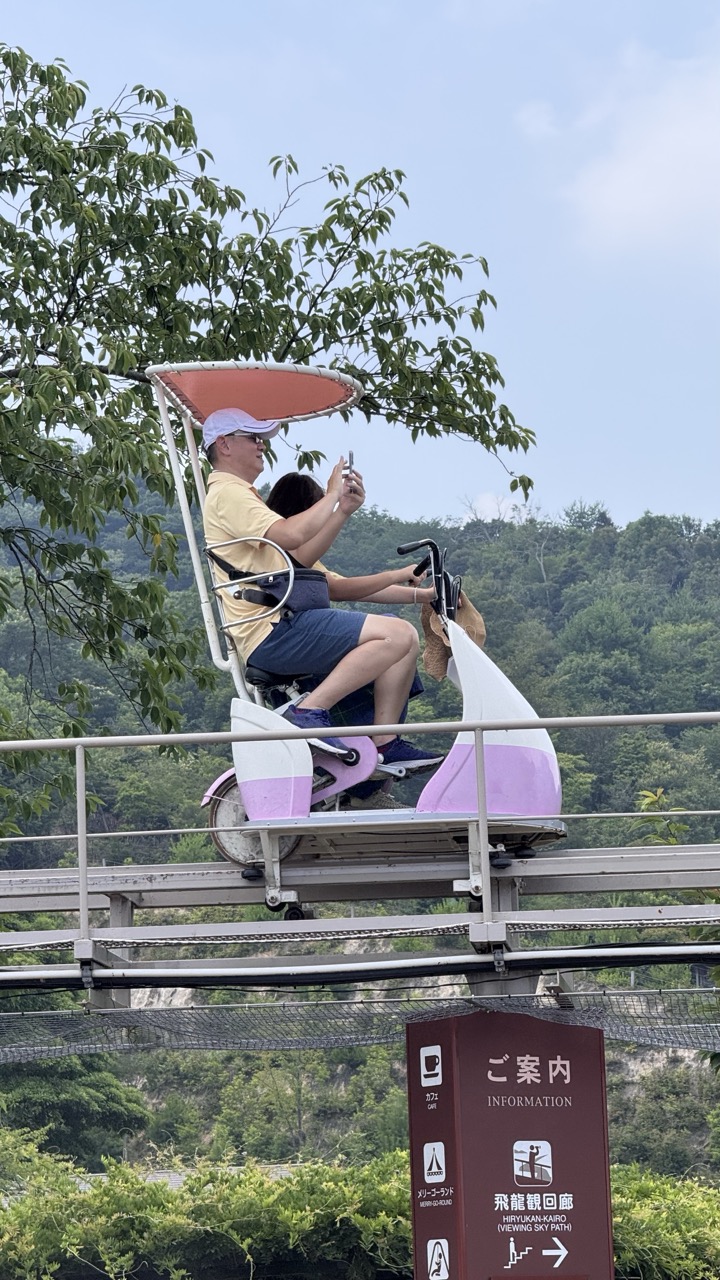

1. Overall Rating (0–10) — 6.0
This photograph captures a candid moment of leisure on a scenic elevated ride, where human interaction with nature and technology blends in a playful, everyday setting. The composition balances the whimsical design of the ride with the lush green backdrop, but the image feels slightly underwhelming due to a lack of dynamic lighting and emotional depth. While the scene is charming and accessible, it remains more observational than evocative, missing the visual punch to elevate it beyond a simple travel snapshot.
2. Composition (0–10) — 6.0
The subject is well-framed, with the riders centered and the canopy drawing the eye, though the foreground sign slightly distracts from the natural beauty of the background. The diagonal of the bridge and the foliage create visual flow, but the image feels slightly cluttered due to the sign and the structural elements.
3. Lighting (0–10) — 5.5
Natural daylight provides even illumination, but the overcast sky softens the light, reducing contrast and depth. The lack of strong shadows or directional light gives the image a flat, neutral quality that diminishes visual drama.
4. Color & Tone (0–10) — 6.5
The palette is harmonious, with the soft pink and white of the ride complementing the green foliage and pale sky. However, the colors are somewhat muted, lacking vibrancy, which tempers the image’s overall appeal.
5. Creativity (0–10) — 6.0
The concept of a shared ride in a scenic location is inherently engaging, and the inclusion of the sign adds context and narrative. However, the execution is conventional, with little innovation in perspective or artistic interpretation.
6. Technical Quality (0–10) — 7.5
The image is sharp and well-focused, with clean details in both the riders and the background. The exposure is balanced, and the camera captures the scene clearly without noticeable noise or distortion.
7. Emotional Impact (0–10) — 5.5
The photograph evokes a sense of lightheartedness and travel adventure, but the emotional resonance is limited by the generic nature of the scene and the lack of a compelling focal point. It feels more like a memory than a moment of profound connection.
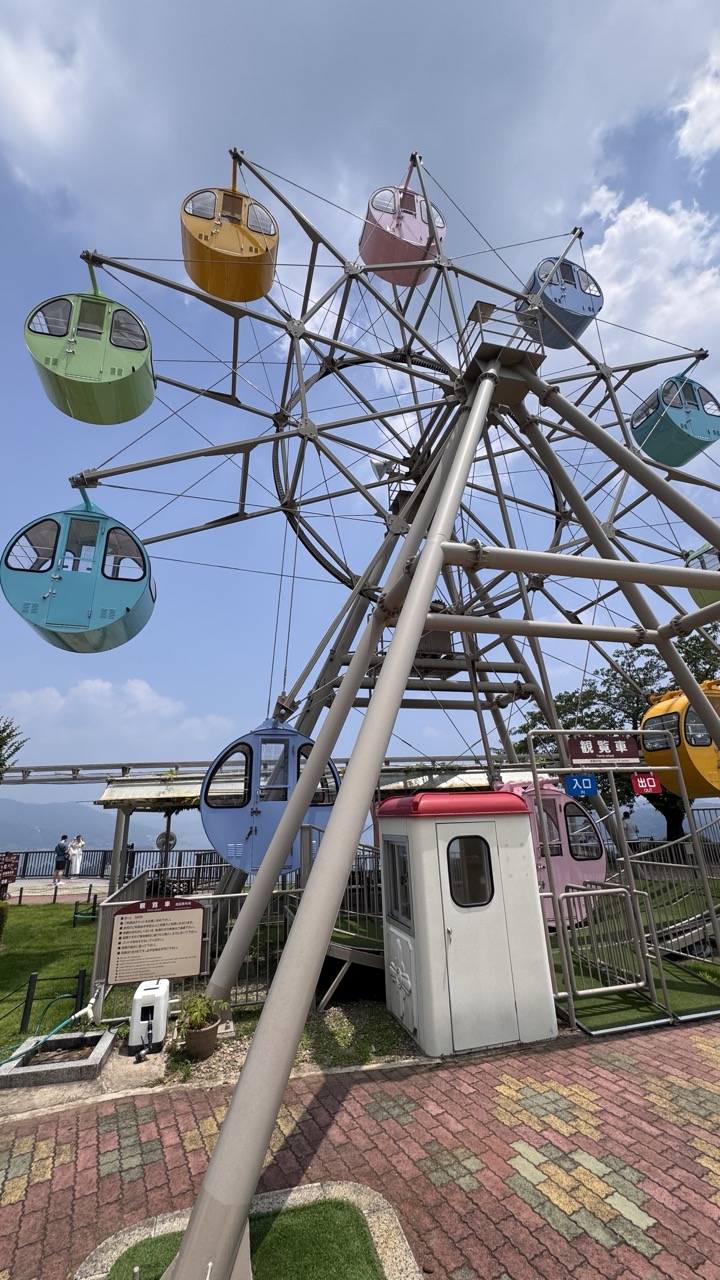

1. Overall Rating (0–10) — 7.0
This photograph captures the whimsical charm of a colorful Ferris wheel set against a bright, cloud-dappled sky, evoking a sense of playful nostalgia. The low-angle perspective amplifies the structure’s scale and presence, while the vibrant gondolas add a cheerful pop of color. Though the scene is visually engaging, the composition feels slightly cluttered by the foreground elements, which detract from the elegance of the ride’s design.
2. Composition (0–10) — 6.5
The low-angle shot emphasizes the Ferris wheel’s towering structure, but the inclusion of the entrance booth and signage in the foreground disrupts visual flow and creates a sense of imbalance.
3. Lighting (0–10) — 7.5
Natural daylight provides even illumination, enhancing the vividness of the gondolas while casting soft shadows that add depth and dimension to the scene.
4. Color & Tone (0–10) — 8.0
The palette is rich and varied, with the pastel hues of the gondolas—yellow, pink, green, and blue—contrasting beautifully against the soft blue sky and earthy tones of the brick pavement.
5. Creativity (0–10) — 7.0
The playful color scheme and perspective offer a fresh take on a familiar amusement park structure, capturing both its mechanical form and emotional appeal in a single frame.
6. Technical Quality (0–10) — 8.0
Sharp focus and clear detail are maintained throughout, from the metallic framework to the signage, demonstrating strong technical execution.
7. Emotional Impact (0–10) — 7.5
The image conveys a sense of lighthearted joy and childlike wonder, inviting the viewer to recall the simple pleasures of a day at the park.
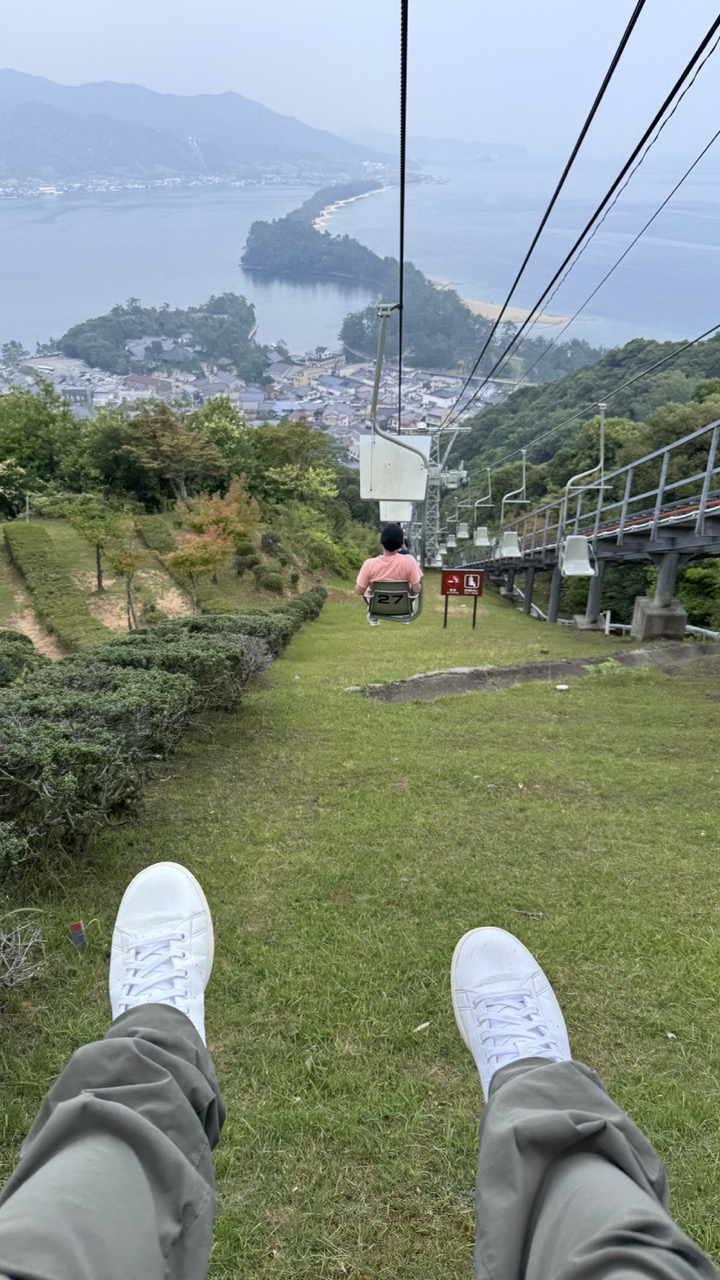

1. Overall Rating (0–10) — 7.0
This photograph captures a serene, introspective moment from a cable car ride, blending personal perspective with expansive natural beauty. The first-person viewpoint draws the viewer into the experience, while the sweeping vista of the bay, islands, and coastal town evokes a sense of peaceful contemplation. The soft, overcast light lends a dreamy quality to the scene, though the slightly cluttered foreground and muted colors temper its visual impact.
2. Composition (0–10) — 7.5
The low-angle, first-person framing creates an immersive perspective, with the legs in the foreground grounding the image in personal experience. The cable car and passenger lead the eye toward the distant town and coastline, creating a strong sense of depth. The diagonal lines of the cable tracks add dynamism, while the natural symmetry of the bay and hills provides visual balance.
3. Lighting (0–10) — 6.5
Diffused, overcast lighting softens the scene and minimizes harsh shadows, contributing to a calm, contemplative mood. While the light is even and flattering for the landscape, it slightly flattens the tonal range and reduces the vibrancy of the colors.
4. Color & Tone (0–10) — 6.0
The palette is dominated by muted greens, grays, and blues, reflecting the overcast conditions. While the natural tones are cohesive and harmonious, the lack of saturation gives the image a subdued, almost melancholic quality, which may limit its emotional punch.
5. Creativity (0–10) — 7.0
The use of a first-person perspective is a strong creative choice, transforming a simple landscape shot into a personal travel moment. The framing suggests storytelling—capturing not just a place, but the feeling of being there—making it more engaging than a standard scenic photo.
6. Technical Quality (0–10) — 7.5
The image is sharp and clear, with good focus on both the foreground and background. The camera is steady, and the exposure is well-balanced, capturing detail in both the grassy hillside and the distant town. There is minimal noise, even in the shaded areas.
7. Emotional Impact (0–10) — 7.0
The photograph evokes a sense of calm and quiet adventure, inviting the viewer to imagine the gentle sway of the cable car and the quiet beauty of the coastal view. The personal perspective enhances emotional connection, making the moment feel intimate and authentic.
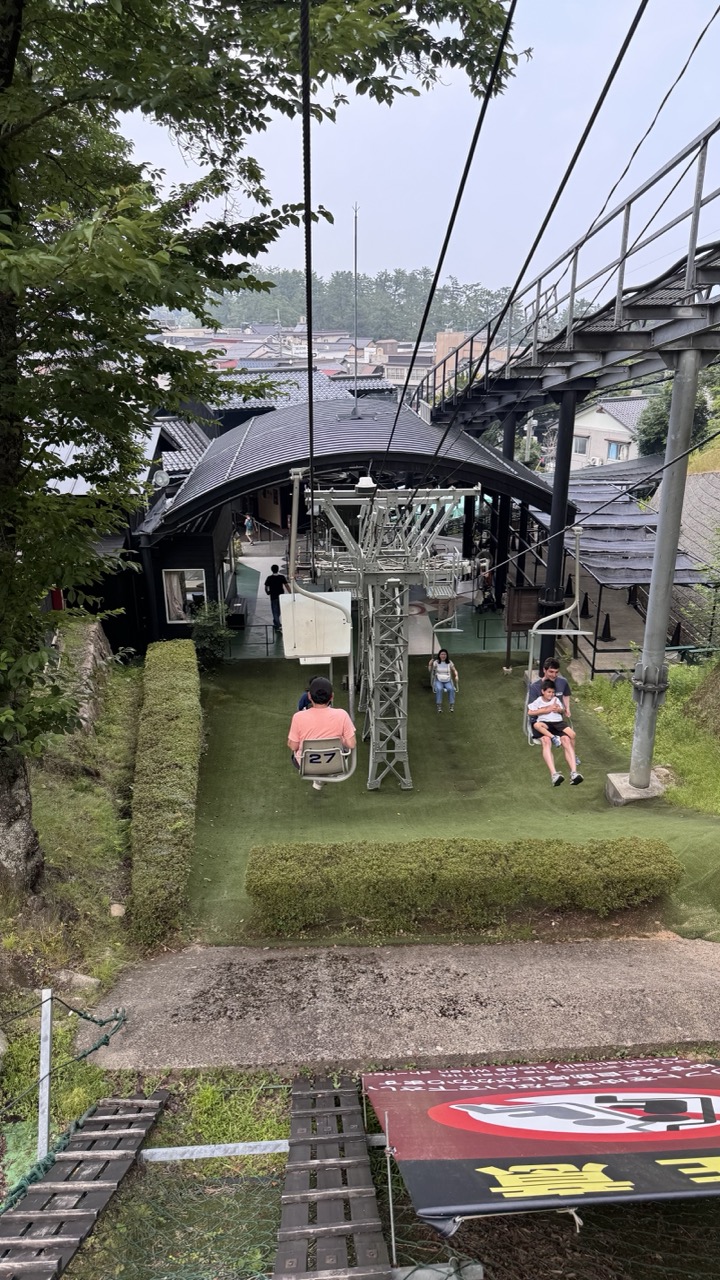

1. Overall Rating (0–10) — 6.0
This photograph captures a candid moment at a cable car station, blending the mundane with the scenic in a way that feels both grounded and slightly dreamy. The overcast sky and lush greenery lend a soft, contemplative mood, while the presence of people adds a sense of everyday life unfolding in a tranquil setting. While the image successfully conveys the atmosphere of a quiet mountain village, its lack of strong visual focus and flat lighting prevent it from feeling truly dynamic or compelling.
2. Composition (0–10) — 5.5
The high vantage point offers a broad view, but the composition feels cluttered, with too many elements competing for attention. The diagonal lines of the cable car structure and the walkway draw the eye in multiple directions, disrupting visual harmony. A tighter crop or more deliberate framing would improve balance and guide the viewer’s gaze more effectively.
3. Lighting (0–10) — 5.0
The overcast conditions result in diffused, flat lighting that minimizes shadows and texture, giving the image a muted quality. While this soft light suits the calm mood, it also flattens the scene and reduces depth, making the colors appear washed out.
4. Color & Tone (0–10) — 5.5
The palette is dominated by muted greens and grays, with the dark roof and metal structures creating a somber tone. While the natural tones are consistent and realistic, the lack of vibrancy or contrast limits the visual impact. A touch of warmth or saturation could elevate the scene.
5. Creativity (0–10) — 6.0
The image captures a slice of life with a quiet, observational charm. Its strength lies in its authenticity and the subtle narrative of people navigating a scenic transport system. However, it doesn’t push beyond the documentary style into more expressive or conceptual territory.
6. Technical Quality (0–10) — 7.0
The image is sharp and clear, with good detail visible in the foreground and midground. Focus is consistent across the frame, and there are no major technical flaws like blur or noise. However, the lack of dynamic range and tonal richness holds back the overall quality.
7. Emotional Impact (0–10) — 5.5
The photograph evokes a sense of peaceful travel and mild nostalgia, particularly for those familiar with mountain resorts or rural Japan. While it captures a quiet, reflective moment, the emotional resonance is restrained by the subdued lighting and lack of a strong focal point, leaving the viewer with a sense of observation rather than connection.
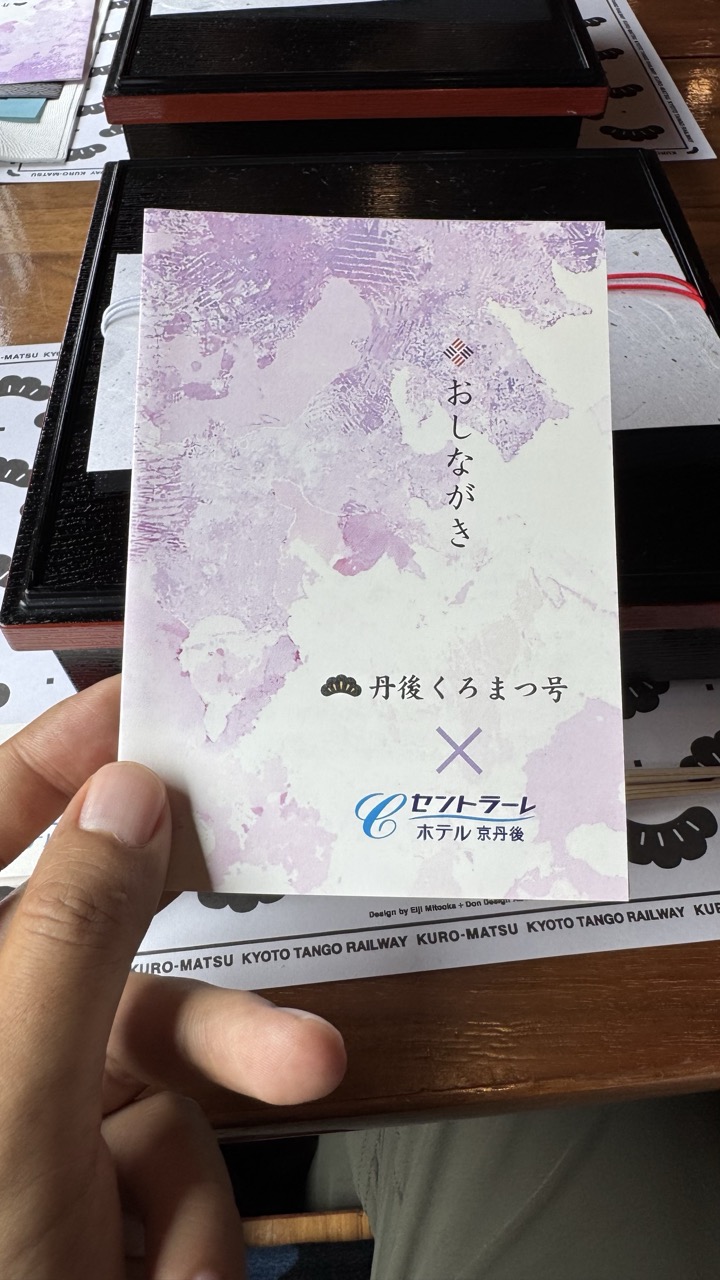

1. Overall Rating (0–10) — 6.0
This photograph captures a quiet, intimate moment of cultural exchange, where a hand holds a menu from a Kyoto-based establishment, suggesting a culinary journey steeped in tradition. The composition, though modest in scale, conveys a sense of authenticity and place, anchored by the elegant Japanese text and soft purple wash that evoke a refined aesthetic. While the image succeeds in documenting a specific experience, its emotional depth is restrained by a lack of visual drama and a somewhat cluttered background that distracts from the central subject.
2. Composition (0–10) — 5.5
The hand and menu are centered but slightly off-kilter, with the background elements—such as the patterned table mat and stacked trays—creating visual noise. A tighter crop would improve focus and emphasize the cultural details.
3. Lighting (0–10) — 6.0
The lighting is even and soft, likely from indoor ambient sources, which preserves the delicate textures of the paper and the subtle ink wash. However, it lacks directional contrast or warmth, giving the scene a neutral, documentary feel.
4. Color & Tone (0–10) — 6.5
The soft lavender and white palette is harmonious and evocative of traditional Japanese design. The tonal range is gentle, with no harsh contrasts, which suits the quiet, contemplative mood, though the colors appear slightly washed out.
5. Creativity (0–10) — 6.0
The image functions more as a personal memento than a conceptual photograph, but its strength lies in the subtle storytelling—the fusion of culinary tradition, transportation branding, and design. The inclusion of the “X” symbol and the collaboration between Kuro-Matsu and Hotel Kyoto adds an intriguing layer of narrative.
6. Technical Quality (0–10) — 7.0
The focus is sharp on the menu, and the details of the text and design are clear. The hand and fingers are slightly out of focus, which is acceptable given the shallow depth of field. The image is free from major technical flaws.
7. Emotional Impact (0–10) — 5.5
There is a quiet nostalgia and appreciation for Japanese culture, but the emotional resonance is limited by the image’s candid, unembellished nature. It invites curiosity about the experience but doesn’t deeply move or engage the viewer.
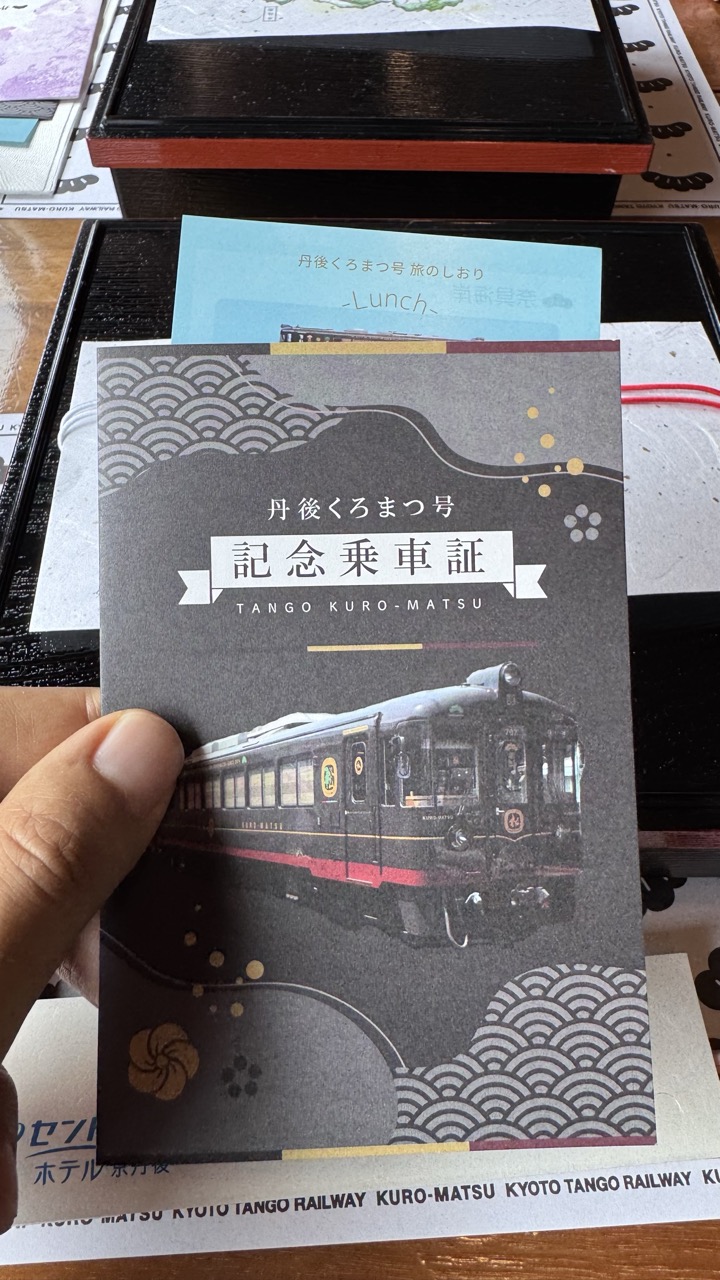

1. Overall Rating (0–10) — 6.8
This image captures a quiet, intimate moment of travel memory, centered on a commemorative train ticket for the Tango Kuro-Matsu. The composition is grounded in authenticity, with the hand holding the ticket adding a personal, human touch. While the background clutter slightly distracts from the subject, the image successfully conveys a sense of nostalgia and cultural appreciation, particularly through the elegant design of the ticket and the subtle Japanese motifs.
2. Composition (0–10) — 6.0
The ticket is well-framed and occupies the central focus, but the surrounding objects—such as the wooden box and scattered papers—create visual noise. A more deliberate arrangement or tighter crop would enhance the image’s clarity and storytelling.
3. Lighting (0–10) — 6.5
The lighting is even and natural, likely from ambient indoor light, which preserves the details of the ticket without harsh shadows. However, the lack of directional light or contrast prevents the image from feeling dynamic or atmospheric.
4. Color & Tone (0–10) — 7.0
The palette is subdued, dominated by black, gray, and soft gold, which complements the traditional Japanese aesthetic. The warm wood tones and the light blue card add subtle contrast, enhancing the image’s visual harmony.
5. Creativity (0–10) — 7.5
The image stands out through its cultural specificity and the thoughtful inclusion of design elements like the wave pattern and golden dots. It transcends a simple snapshot by framing a personal artifact as a symbol of travel and memory.
6. Technical Quality (0–10) — 7.5
The focus is sharp on the ticket, with clear legibility of the text and crisp details of the train illustration. The image is free from noise and distortion, indicating solid technical execution.
7. Emotional Impact (0–10) — 7.0
There is a quiet warmth in the image, evoking a sense of personal journey and connection to place. The viewer is invited to imagine the trip, the train, and the experience behind the ticket, making it emotionally resonant for those familiar with Japanese rail culture.
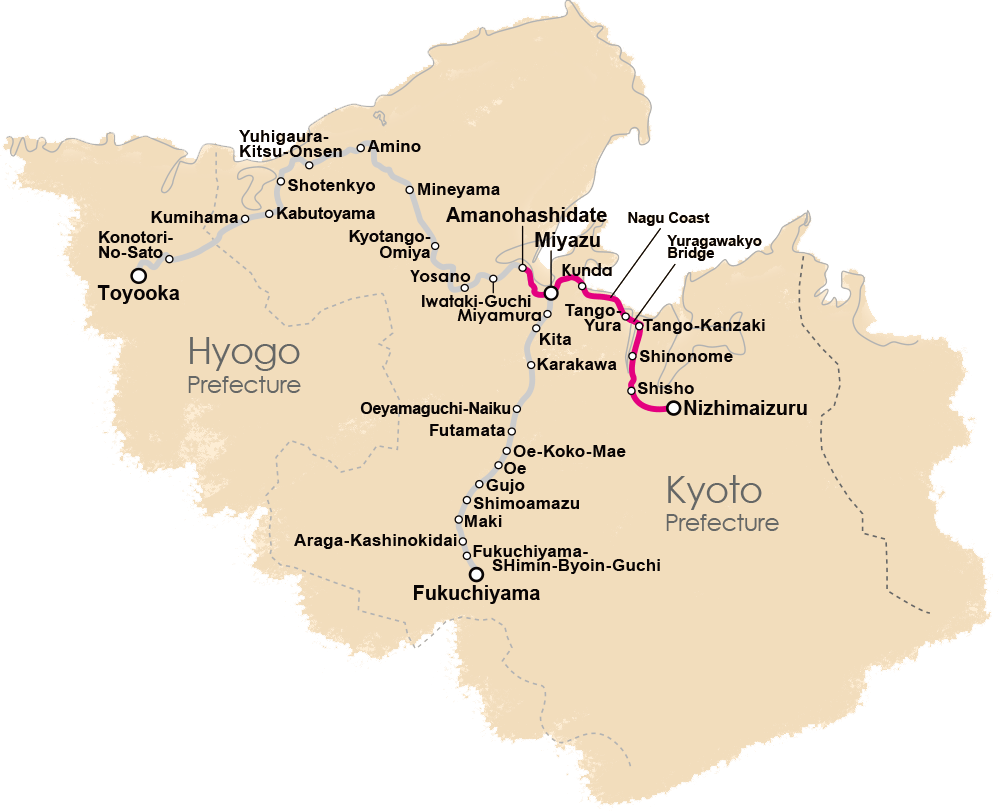

1. Overall Rating (0–10) — 7.0
This map effectively communicates a regional journey through western Japan, blending geographical clarity with cultural and historical context. The use of a muted, earthy palette and clean typography lends a sense of timelessness, while the highlighted route draws the eye with purpose. Though functional by design, it subtly evokes the rhythm of travel along a historic path, inviting contemplation of the places and stories en route. A more dynamic color gradient or scale could enhance visual engagement, but as a navigational and informational tool, it succeeds admirably.
2. Composition (0–10) — 7.5
The map is well-balanced, with the pink route centrally guiding the viewer’s gaze from Nishimaizuru to Toyooka. The placement of key locations and regional boundaries is clear and uncluttered, allowing for easy reading. The use of negative space around the map enhances focus, while the inclusion of both prefectural labels and route markers creates a layered, informative layout.
3. Lighting (0–10) — N/A
As a graphic illustration rather than a photograph, lighting is not applicable; the image uses consistent, flat illumination to maintain clarity and legibility.
4. Color & Tone (0–10) — 7.0
The soft beige background and muted tones create a harmonious, understated aesthetic, evoking a sense of tradition and geography. The magenta route provides a subtle but effective contrast, drawing attention without overwhelming the composition. The limited palette supports the map’s informative intent while lending it a gentle, contemplative mood.
5. Creativity (0–10) — 6.5
The design is functional and restrained, prioritizing clarity over artistic flourish. However, the thoughtful integration of place names and the gentle curve of the route suggest an intention to evoke a narrative journey, transforming a simple map into a visual story of movement and connection.
6. Technical Quality (0–10) — 8.0
The typography is clean and legible, with consistent font weight and spacing. Lines and labels are sharp and precise, indicating high-quality design and production. The map’s simplicity enhances its technical effectiveness, with no visual distractions or errors.
7. Emotional Impact (0–10) — 6.0
The image evokes a quiet sense of exploration and connection to place, especially for those familiar with the region or the cultural significance of the route. While not emotionally charged, it invites reflection on travel, history, and the quiet beauty of regional journeys.
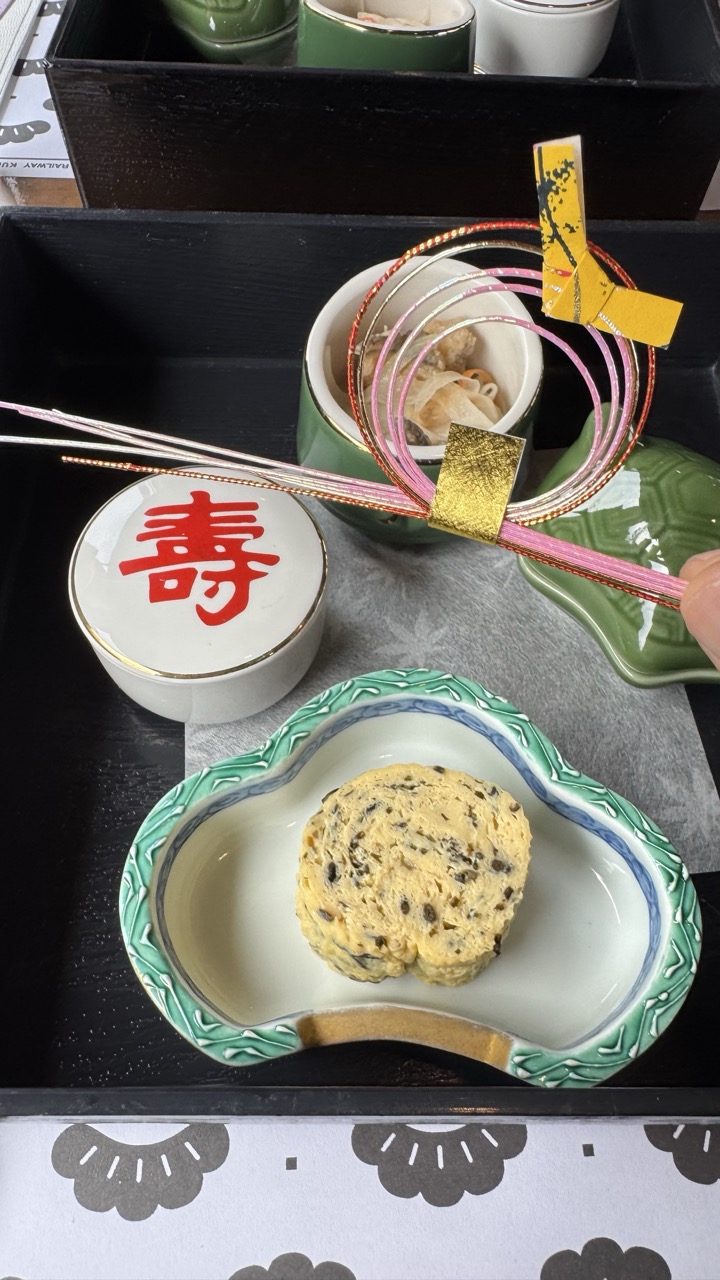

1. Overall Rating (0–10) — 7.0
This photograph captures the elegance and cultural richness of a traditional Japanese tea service, where each element—from the delicate ceramics to the symbolic decoration—speaks of ritual and care. The composition balances detail and context well, inviting the viewer into a moment of quiet celebration. While the framing feels slightly cluttered, the cultural significance and aesthetic harmony elevate the image beyond mere documentation into something evocative and meaningful.
2. Composition (0–10) — 6.5
The arrangement feels slightly crowded, with overlapping objects creating visual busyness. However, the central placement of the tamagoyaki and the prominent "寿" character anchor the frame, drawing the eye through a natural visual path. A tighter crop would enhance focus and clarity.
3. Lighting (0–10) — 7.0
Soft, diffused lighting enhances the textures of the food and ceramics without creating harsh shadows. The even illumination allows the colors and details to emerge naturally, supporting the serene and refined mood of the scene.
4. Color & Tone (0–10) — 7.5
The palette is harmonious, with the green of the ceramic vessels complementing the warm yellow of the tamagoyaki and the bold red of the "寿" character. The contrast between the dark tray and lighter elements adds depth, while the gold accents lend a touch of celebratory richness.
5. Creativity (0–10) — 7.0
The image successfully blends tradition and visual storytelling, using symbolic elements like the bamboo skewers and the "寿" (longevity) motif to convey deeper meaning. While not radically original in concept, the thoughtful arrangement and cultural cues make it artistically compelling.
6. Technical Quality (0–10) — 7.5
The focus is sharp on the central dish and container, with clear detail in the textures of the food and ceramics. The image is well-exposed, with minimal noise, and the alignment of elements suggests careful composition.
7. Emotional Impact (0–10) — 7.0
There’s a quiet warmth and reverence in the image, evoking feelings of celebration, tradition, and care. The viewer is invited to appreciate not just the food, but the cultural significance and the ritual behind the presentation, creating a moment of connection and reflection.
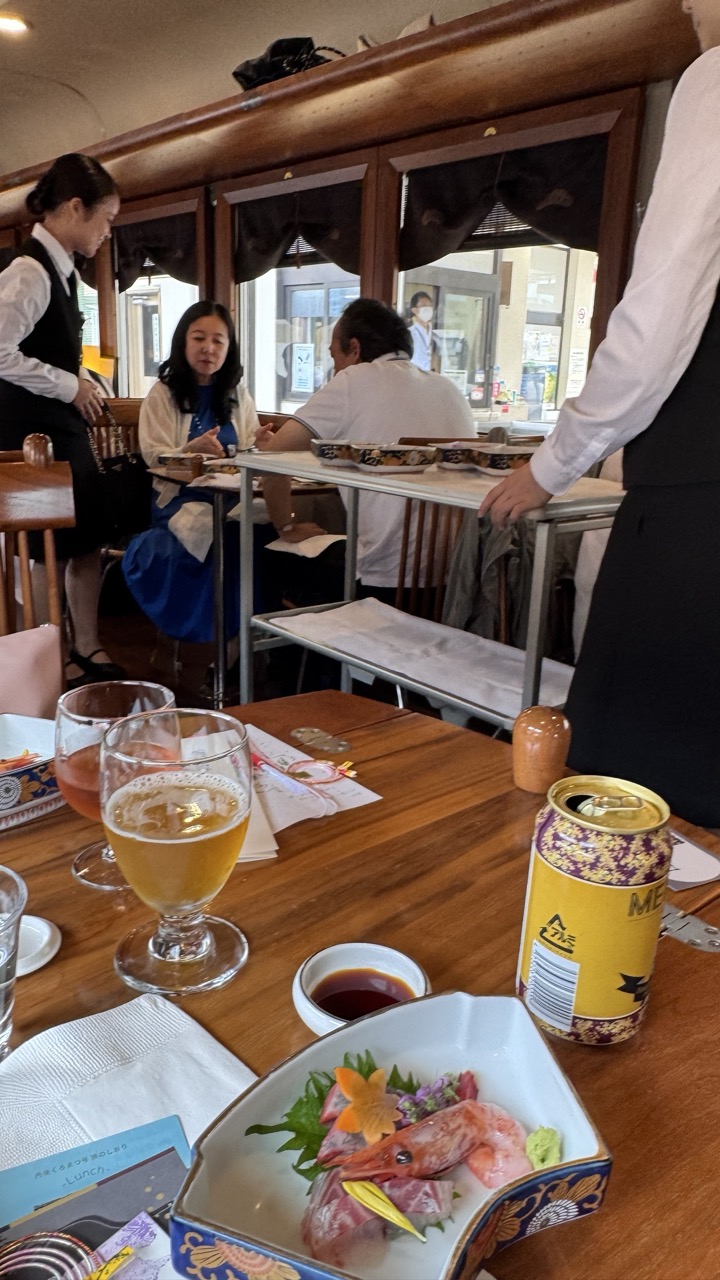

1. Overall Rating (0–10) — 6.8
This photograph captures the quiet intimacy of a traditional Japanese dining experience, where the warmth of shared food and service unfolds in a modest, lived-in space. The foreground’s vibrant sashimi and beer invite the viewer into the moment, while the background activity adds a sense of authenticity and rhythm. While the composition feels slightly cluttered and the lighting lacks refinement, the image succeeds in conveying a genuine slice of daily life—its charm lies in its candidness rather than its polish.
2. Composition (0–10) — 6.0
The foreground elements dominate the frame, drawing focus to the food, while the midground and background create a layered, albeit slightly unbalanced, depth. The diagonal line of the table and the positioning of the server create a dynamic flow, but the framing feels slightly off-center and crowded.
3. Lighting (0–10) — 5.5
Natural light filters in from the windows, creating a soft, diffused illumination that feels authentic to the setting. However, the overall lighting is flat and uneven, with shadows in the corners and a lack of directional emphasis that diminishes visual drama.
4. Color & Tone (0–10) — 6.5
The warm wood tones of the table and cabinetry provide a rich, earthy base, complemented by the bright colors of the sashimi and the golden beer. The yellow can adds a pop of saturated color, though the overall palette remains muted and slightly washed out by the ambient light.
5. Creativity (0–10) — 6.0
The image is observational and grounded in realism, capturing a moment without overt artistic manipulation. The choice to foreground the meal while including the surrounding activity suggests a narrative of connection and service, but the approach is conventional rather than inventive.
6. Technical Quality (0–10) — 7.0
The image is sharp and clear, with good detail in the foreground elements like the sashimi and glassware. Focus is consistent across the frame, though slight noise in the background reduces clarity.
7. Emotional Impact (0–10) — 6.5
There’s a quiet warmth in the scene—the gentle interaction between staff and guests, the care in the presentation of food—that evokes a sense of comfort and connection. While not emotionally overwhelming, the photograph conveys a gentle invitation into a moment of shared nourishment.
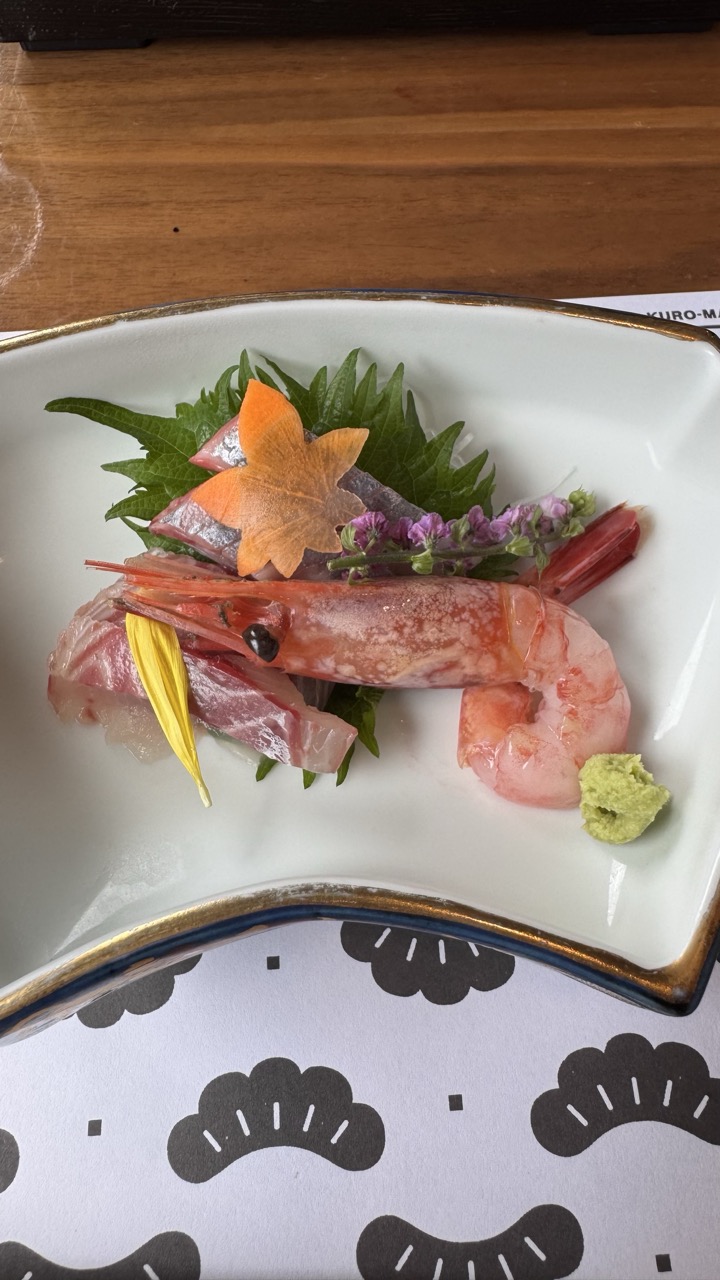

1. Overall Rating (0–10) — 8.0
This photograph captures the delicate elegance of a Japanese sashimi platter with a quiet reverence for tradition and artistry. The careful arrangement of fresh seafood, vibrant garnishes, and subtle textures conveys a sense of refined culinary craftsmanship. While the composition is largely successful, the slightly cluttered background and uneven lighting slightly detract from the dish’s visual harmony, preventing it from achieving a truly transcendent presentation.
2. Composition (0–10) — 7.5
The dish is centered with intentional asymmetry, following traditional Japanese plating principles, but the plate’s curved edge intrudes into the frame, creating a slightly disruptive diagonal. The background pattern competes for attention, though the overall arrangement remains balanced and visually engaging.
3. Lighting (0–10) — 6.5
Natural, diffused light softly illuminates the dish, enhancing the freshness of the ingredients. However, a slight underexposure in the lower portion casts a dim shadow, reducing the clarity of the wasabi and the lower part of the plate.
4. Color & Tone (0–10) — 8.0
The palette is rich and harmonious, with the pink of the shrimp, the deep green of the shiso, and the orange maple leaf creating a visually pleasing contrast. The gold trim adds warmth, while the muted background pattern allows the colors of the food to stand out.
5. Creativity (0–10) — 8.5
The use of seasonal garnishes—such as the delicate purple flowers and the paper maple leaf—demonstrates thoughtful, seasonal storytelling. The composition feels both authentic and artistically curated, reflecting a deep respect for the cultural context of the dish.
6. Technical Quality (0–10) — 7.0
The image is sharp and detailed, with good focus on the sashimi and garnishes. However, the depth of field is narrow, and some areas—particularly the lower edge of the plate—appear slightly out of focus.
7. Emotional Impact (0–10) — 7.5
The photograph evokes a sense of tranquility and appreciation for fine dining. The attention to detail invites the viewer to pause and consider the care behind the meal, creating a quiet emotional resonance rooted in ritual and beauty.
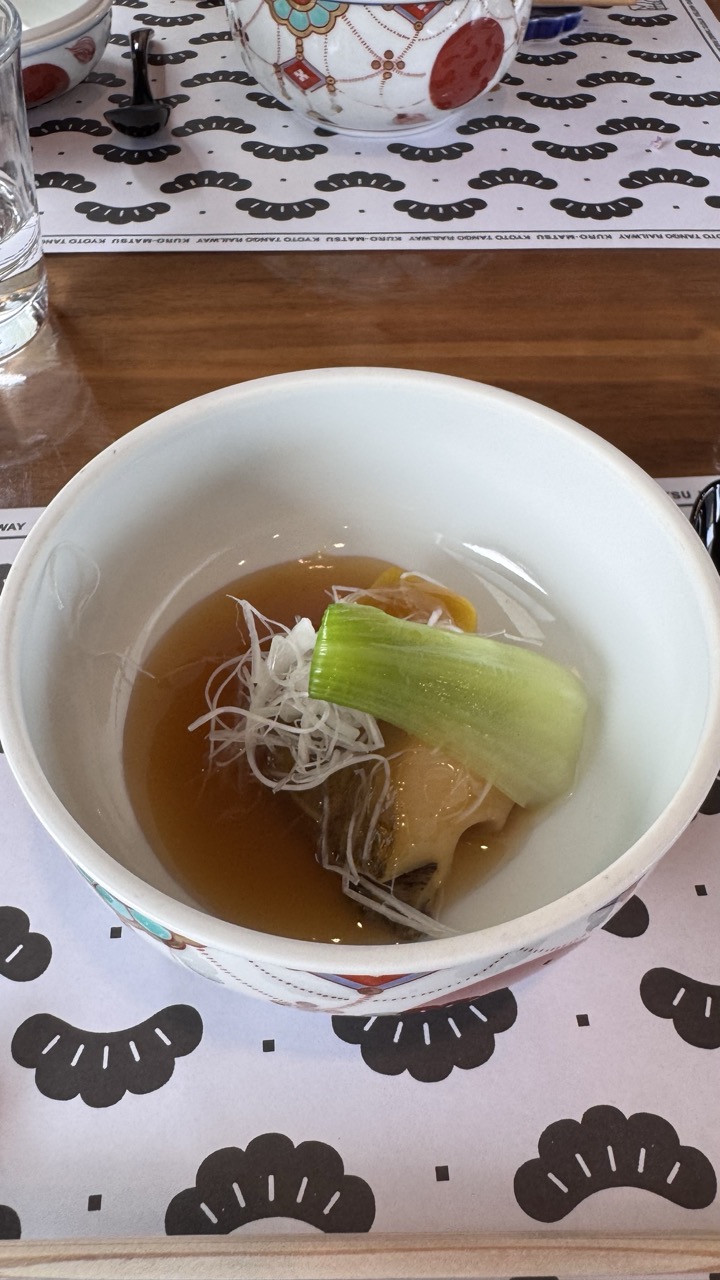

1. Overall Rating (0–10) — 7.0
This photograph captures a moment of serene culinary tradition, where a delicate Japanese soup is presented with quiet elegance. The composition centers on the bowl’s contents, drawing attention to the textures and colors of the ingredients, while the patterned placemat adds cultural context without overwhelming the scene. While the image is visually inviting, it feels slightly restrained by its flat lighting and lack of dynamic contrast, holding back its full potential to feel immersive.
2. Composition (0–10) — 7.5
The bowl is well-centered, creating a balanced focal point, and the background elements—teapot, placemat, and glass—add depth without distraction. The slight angle enhances the sense of intimacy, though a tighter crop could further emphasize the dish’s details.
3. Lighting (0–10) — 6.0
Soft, ambient light illuminates the scene evenly, but lacks directional warmth or contrast, resulting in a somewhat flat appearance. The reflections on the soup’s surface add subtle interest, but the overall lighting fails to evoke a strong mood.
4. Color & Tone (0–10) — 7.0
The warm broth contrasts gently with the green scallion and white shredded garnish, creating a harmonious palette. The patterned placemat introduces black and muted tones, which complement the white ceramic without clashing. The color balance feels natural and restrained, aligning with the dish’s calm aesthetic.
5. Creativity (0–10) — 6.5
The image presents a familiar subject with thoughtful composition and cultural detail, but the approach is conventional. The focus on authenticity over artistic flair limits its originality, though the cultural context adds a layer of narrative depth.
6. Technical Quality (0–10) — 7.5
The focus is sharp on the bowl’s contents, and the image is free of noise or blur. The clarity of textures—such as the fine shreds of garnish and the smooth surface of the broth—enhances the visual appeal, though the lighting could be more dynamic.
7. Emotional Impact (0–10) — 6.5
The photograph evokes a sense of quiet comfort and tradition, inviting the viewer to imagine the warmth and flavor of the dish. While not emotionally charged, it succeeds in conveying a peaceful, reflective moment tied to food and culture.
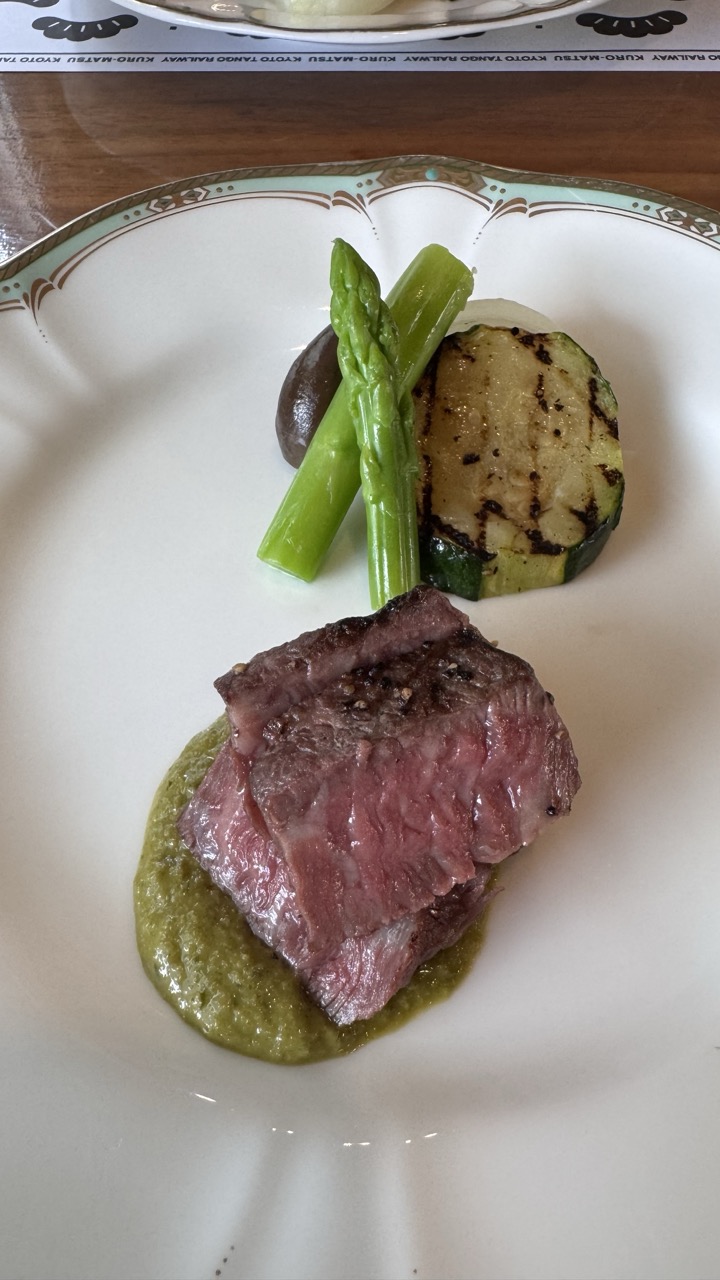

1. Overall Rating (0–10) — 7.5
This photograph captures a refined culinary moment with a strong sense of elegance and intentionality. The dish’s composition—featuring a perfectly seared slice of meat atop a vibrant green puree, accompanied by grilled zucchini and tender asparagus—feels both artful and appetizing. The clean white plate and subtle gold detailing enhance the refined presentation, though the slightly awkward framing and background distractions slightly diminish the overall impact. The image successfully conveys a sense of luxury dining, but could benefit from tighter composition and a more deliberate visual focus.
2. Composition (0–10) — 6.5
The subject is well-centered, but the framing cuts off the top edge of the plate and includes an intrusive background element—the placemat text—which pulls attention away from the dish. A tighter crop would enhance focus and balance.
3. Lighting (0–10) — 7.0
The lighting is soft and even, likely from overhead ambient sources, which highlights the textures of the food without harsh shadows. The highlights on the plate and the moist surface of the meat add depth, though the lighting lacks dramatic contrast.
4. Color & Tone (0–10) — 7.5
The palette is harmonious, with the green puree and asparagus complementing the rich brown of the seared meat and the earthy tones of the grilled zucchini. The white plate acts as a clean canvas, allowing the colors to pop with natural vibrancy.
5. Creativity (0–10) — 7.0
The arrangement reflects a thoughtful approach to plating, combining texture, color, and form in a way that suggests a curated dining experience. The inclusion of the branded placemat subtly hints at a specific location, adding narrative context.
6. Technical Quality (0–10) — 8.0
The image is sharp, with clear focus on the food. The depth of field isolates the dish effectively, and the detail in the meat’s crust and the grill marks is well captured.
7. Emotional Impact (0–10) — 7.0
The photograph evokes a sense of indulgence and care, inviting the viewer to imagine the flavors and textures. While not emotionally overwhelming, it successfully conveys the pleasure and sophistication of a high-end meal.
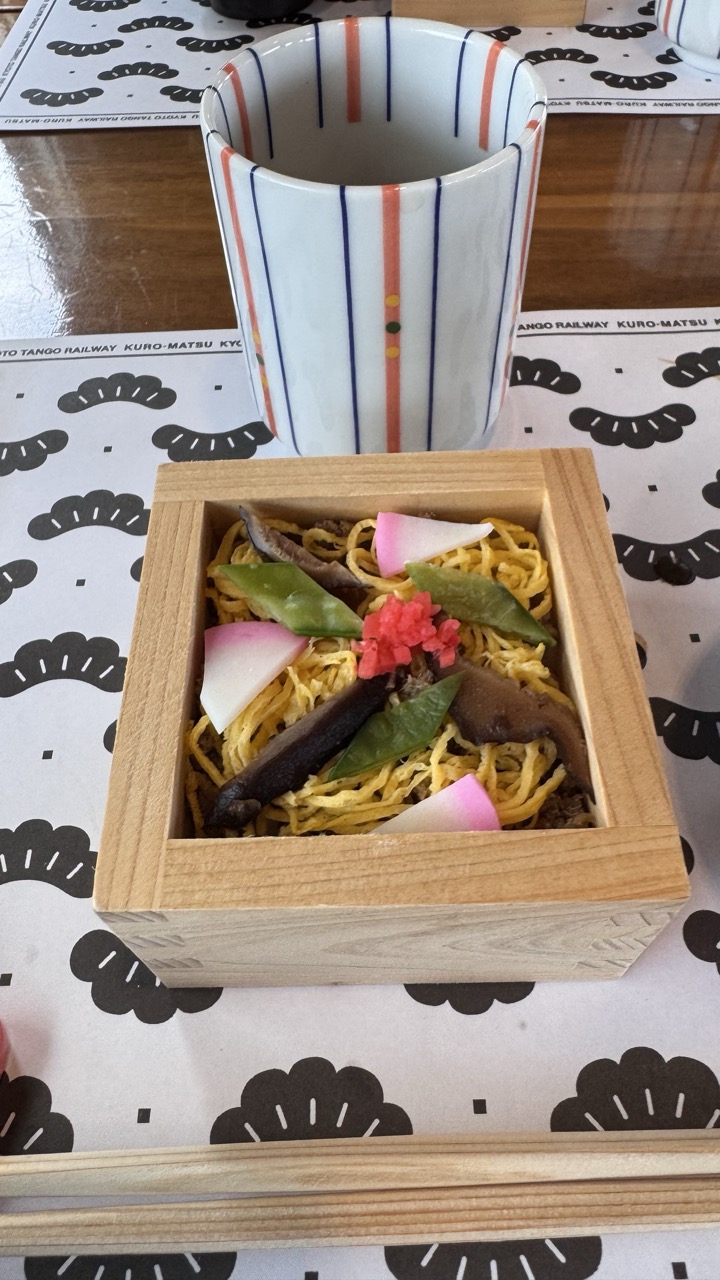

1. Overall Rating (0–10) — 7.0
This photograph captures a serene moment of Japanese culinary tradition, with the vibrant bento box and patterned tableware evoking a sense of cultural authenticity. The composition is balanced and inviting, though slightly hindered by the cluttered foreground and uneven lighting, which distract from the dish’s delicate presentation. The image succeeds as a visual celebration of food and place, but could benefit from more refined staging to elevate its aesthetic impact.
2. Composition (0–10) — 6.5
The bento box is centered effectively, drawing focus to the meal, but the chopsticks and lower edge of the frame create a visually busy foreground that disrupts the clean lines of the composition.
3. Lighting (0–10) — 6.0
Natural light illuminates the scene adequately, but the reflections on the table and the subtle shadows suggest a mix of ambient and direct light, resulting in uneven exposure that softens details.
4. Color & Tone (0–10) — 7.5
The warm yellows of the noodles, soft pinks and greens of the garnishes, and the earthy wood tones create a harmonious palette. The striped cup adds a playful contrast, enhancing the visual rhythm without overwhelming the subject.
5. Creativity (0–10) — 7.0
The image celebrates cultural specificity through its choice of subject and design elements, blending everyday dining with artistic presentation. While not groundbreaking, it communicates a clear narrative of regional identity and culinary pride.
6. Technical Quality (0–10) — 7.0
The image is sharp and clear, with good focus on the bento box and cup. The depth of field is sufficient to keep the main subject in focus while softly blurring the background, though minor distractions in the foreground reduce overall clarity.
7. Emotional Impact (0–10) — 6.5
The photograph evokes a sense of calm and appreciation for simple pleasures, inviting the viewer to imagine the taste and aroma of the dish. It conveys warmth and authenticity, though the emotional resonance is slightly muted by the composition’s lack of refinement.


1. Overall Rating (0–10) — 7.0
This photograph captures a quiet, contemplative moment aboard a train or ferry, where two women sit in quiet repose, gazing out at a coastal landscape. The warm wood tones and soft natural light lend a nostalgic, almost cinematic quality to the scene, evoking a sense of journey and introspection. While the composition is thoughtful and the mood is serene, the image feels slightly underexposed and lacks the visual punch to fully resonate.
2. Composition (0–10) — 7.5
The symmetrical framing of the windows and the balanced placement of the two figures create a harmonious structure. The diagonal line of the table and the alignment of the windows draw the eye through the image, while the empty chair on the right adds narrative depth and invites the viewer to imagine the story behind the moment.
3. Lighting (0–10) — 6.5
Natural light streams in from the windows, creating a soft, diffused glow that enhances the contemplative mood. However, the overall exposure is slightly low, dimming the details of the interior and muting the vibrancy of the exterior scenery.
4. Color & Tone (0–10) — 6.0
The palette is subdued, dominated by earthy browns, soft whites, and muted blues, which contribute to the tranquil atmosphere. While cohesive, the colors lack richness and contrast, making the image feel somewhat flat and lacking in visual dynamism.
5. Creativity (0–10) — 7.0
The photograph captures a poetic, almost cinematic stillness, suggesting a narrative of travel and reflection. The use of the train or ferry setting, combined with the quiet interaction of the subjects, offers a subtle commentary on solitude and connection, lending the image a quiet originality.
6. Technical Quality (0–10) — 7.0
The image is sharp and well-focused, with clean detail in the foreground objects and the subjects’ forms. The depth of field is appropriately controlled, keeping both the interior and the distant landscape in view. However, the overall image could benefit from better exposure control to enhance clarity and richness.
7. Emotional Impact (0–10) — 7.5
The image evokes a sense of calm and introspection, inviting the viewer to pause and reflect on the quiet beauty of everyday moments. The two women, absorbed in their own thoughts, create a poignant sense of shared solitude, making the photograph emotionally resonant and gently moving.
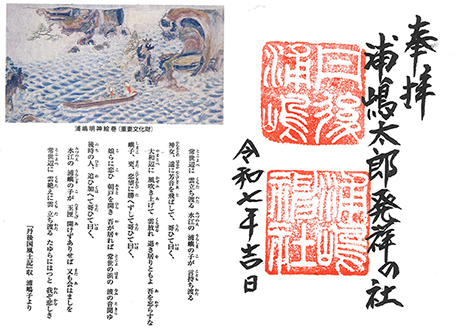

1. Overall Rating (0–10) — 6.0
This image presents a layered composition that blends traditional Japanese art with textual and calligraphic elements, evoking a sense of cultural reverence and historical continuity. The juxtaposition of the ukiyo-e-style illustration with the formal seals and script creates a narrative of tradition being preserved and honored. While the visual cohesion is strong, the dense arrangement of text and symbols risks overwhelming the viewer, and the image’s purpose—whether artistic, commemorative, or archival—remains somewhat ambiguous without deeper context.
2. Composition (0–10) — 6.0
The layout balances visual and textual elements across the frame, with the illustration on the left and calligraphy and seals on the right, creating a deliberate asymmetry. However, the lack of clear visual hierarchy and the tight clustering of text and seals on the right side create a sense of visual crowding, reducing the impact of each individual component.
3. Lighting (0–10) — 7.0
The lighting is flat and even, appropriate for a scanned or photographed document, ensuring all text and imagery are legible. While the lack of dramatic lighting limits mood, it serves the functional purpose of clarity and documentation.
4. Color & Tone (0–10) — 6.0
The dominant red of the seals contrasts sharply with the monochrome background and text, drawing attention to the official nature of the document. The limited palette—primarily red, black, and white—reinforces a formal, traditional aesthetic, though the absence of tonal variation in the illustration slightly dulls its visual appeal.
5. Creativity (0–10) — 6.5
The integration of a traditional woodblock-style illustration with modern Japanese calligraphy and official seals demonstrates a thoughtful blending of artistic and institutional elements. The design reflects a cultural narrative, suggesting the preservation of heritage, though the execution leans more toward documentation than conceptual innovation.
6. Technical Quality (0–10) — 7.5
The image is clear and well-focused, with sharp details in the seals, text, and illustration. The scan or photograph is of high resolution, preserving the fine lines of the calligraphy and the texture of the seals, though some minor compression artifacts may be present in the scanned area.
7. Emotional Impact (0–10) — 6.0
The image conveys a sense of respect and formality, particularly through the use of seals and formal script, suggesting a moment of commemoration or dedication. While it does not evoke strong emotion, it invites quiet reflection on cultural continuity and the weight of tradition.
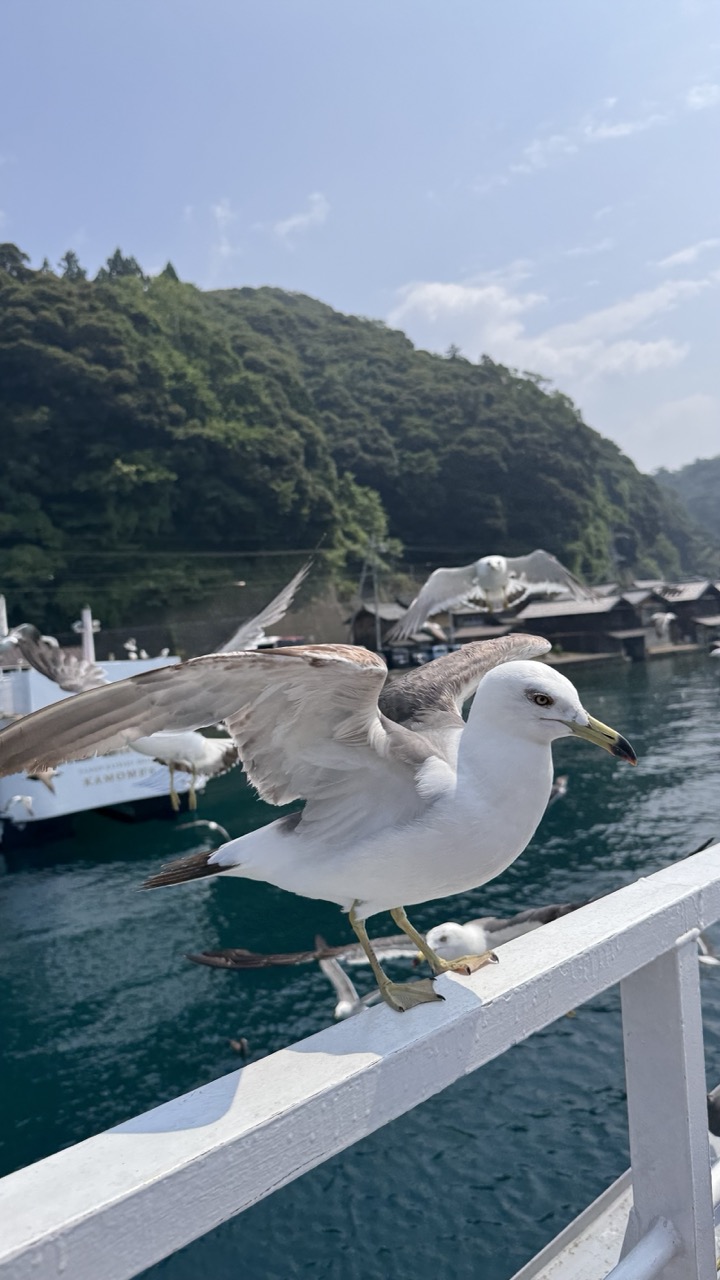

1. Overall Rating (0–10) — 7.0
This photograph captures a dynamic moment of avian activity at a coastal harbor, where the energy of flying gulls contrasts with the stillness of the surrounding landscape. The composition draws the eye to the bird in the foreground, whose outstretched wings suggest motion and immediacy, while the lush green hillside and calm water provide a serene backdrop. While the scene is lively and well-framed, the slightly overexposed sky and busy background reduce the image’s visual cohesion, preventing it from achieving a more polished and immersive quality.
2. Composition (0–10) — 7.5
The foreground gull is well-placed and dominant, with the white railing leading the eye into the frame. The layered depth—bird, water, buildings, and hill—creates a sense of space, though the background activity adds slight distraction.
3. Lighting (0–10) — 6.5
Natural daylight illuminates the scene evenly, but the bright sky is slightly overexposed, washing out detail. The sunlight enhances the texture of the gull’s feathers and reflects off the water, adding a lively quality.
4. Color & Tone (0–10) — 7.0
The contrast between the deep blue-green water and the lush green hillside creates a vibrant palette. The white of the gull and railings grounds the image, while the natural tones feel authentic and harmonious.
5. Creativity (0–10) — 7.5
The capture of multiple gulls in flight, combined with the foreground subject, gives the image a narrative quality—suggesting a moment of daily life at a working waterfront. The perspective feels spontaneous and engaging.
6. Technical Quality (0–10) — 7.0
The focus is sharp on the main subject, and the image is free from significant noise. However, the exposure is uneven, with highlights in the sky and reflections on the water appearing slightly blown out.
7. Emotional Impact (0–10) — 6.5
The scene evokes a sense of coastal vitality and natural rhythm, with the gulls’ movement conveying a feeling of freedom and urgency. The viewer is drawn into the moment, though the lack of deeper emotional contrast keeps the connection at a surface level.
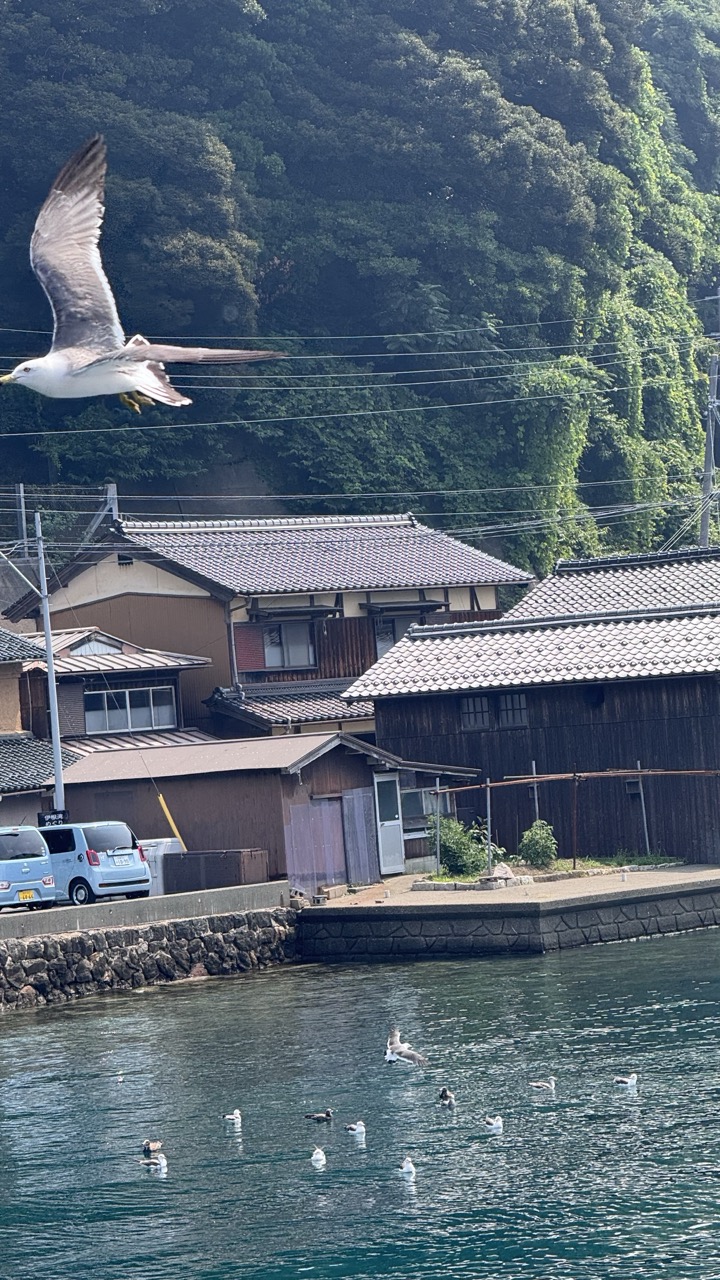

1. Overall Rating (0–10) — 7.0
This photograph captures a serene coastal village scene with a dynamic sense of movement, where a soaring seagull adds life and narrative to the tranquil waters and traditional architecture. The juxtaposition of natural and human elements—lush green hills, tiled roofs, and calm water—creates a peaceful yet vivid atmosphere. While the composition is strong and the moment feels authentic, the image's emotional depth is slightly restrained by the lack of a more intentional focal point or tonal cohesion.
2. Composition (0–10) — 6.5
The seagull’s diagonal flight path draws the eye across the frame, creating a sense of motion. However, the cluttered foreground and scattered elements—cars, power lines, and buildings—distract from the central harmony, creating visual tension rather than balance.
3. Lighting (0–10) — 7.0
Natural daylight illuminates the scene evenly, highlighting the textures of the wooden buildings and the ripples on the water. The bright light enhances clarity but reduces atmospheric depth, giving the image a slightly flat quality.
4. Color & Tone (0–10) — 7.5
The palette is rich with natural tones—deep greens of the forest, muted browns of the structures, and the cool teal of the water—creating a cohesive and calming visual. The white of the seagull provides a strong contrast that draws attention without disrupting harmony.
5. Creativity (0–10) — 7.0
The image successfully captures a moment of everyday life with an artistic eye, using the flying bird to infuse energy into a quiet setting. The blend of tradition and nature is evocative, though the composition leans more toward documentation than bold interpretation.
6. Technical Quality (0–10) — 8.0
The image is sharp and clear, with well-defined details in both the foreground and background. Focus is accurate, and the exposure is balanced, allowing the textures and colors to appear natural and vivid.
7. Emotional Impact (0–10) — 6.5
The scene evokes a sense of calm and familiarity, inviting the viewer to imagine the quiet rhythm of life in a seaside village. While emotionally resonant, the moment feels more observational than deeply moving, leaving room for greater emotional engagement.
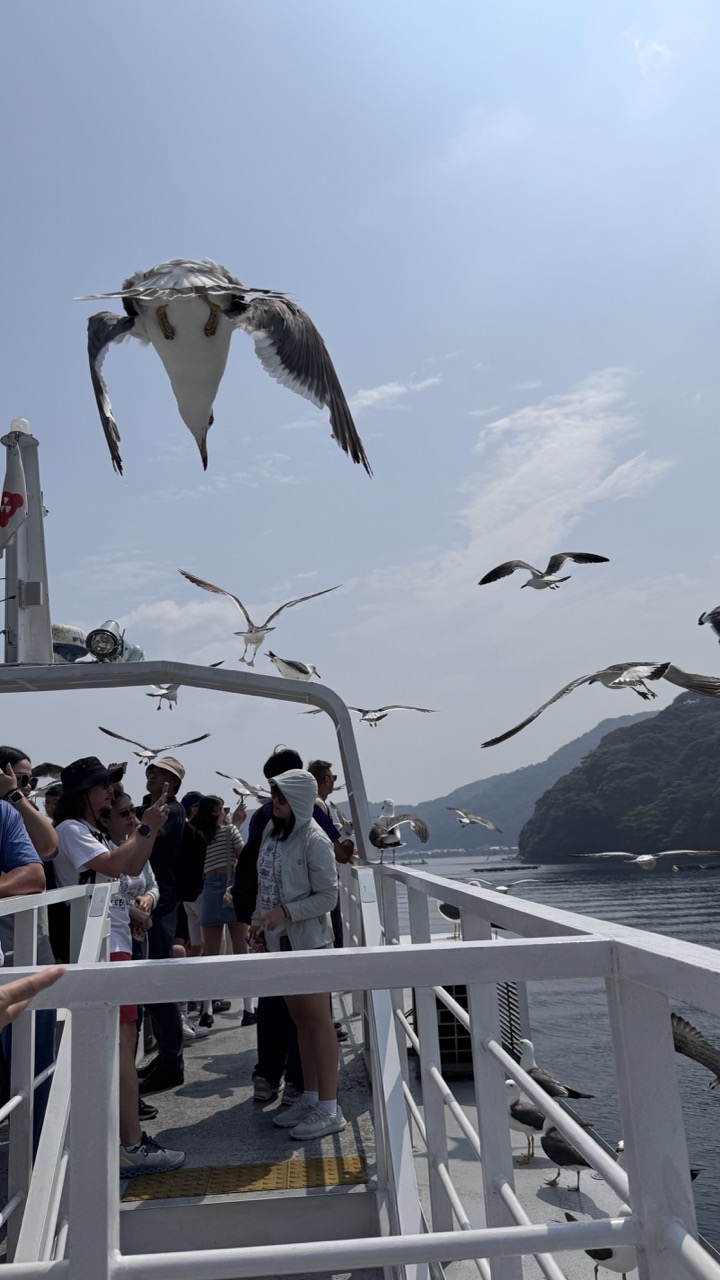

1. Overall Rating (0–10) — 7.0
This photograph captures a dynamic and lively moment aboard a boat, where humans and seagulls interact in a burst of motion and energy. The central seagull, suspended mid-flight with its wings fully spread, creates a dramatic focal point that draws the eye upward, while the surrounding flock and the engaged crowd add narrative depth. Though the composition feels slightly unbalanced due to the crowded foreground, the scene’s spontaneity and natural energy give it a compelling, candid quality that resonates with the joy of travel and wildlife encounters.
2. Composition (0–10) — 6.0
The framing is slightly cluttered, with the white railings and passengers creating visual noise that competes with the main action. The low-angle perspective emphasizes the seagulls’ flight but also compresses the background, limiting the sense of space.
3. Lighting (0–10) — 7.0
Bright, natural daylight enhances the clarity and detail of the birds and people. The strong overhead sun creates subtle shadows and highlights the texture of the seagulls’ feathers, though some areas of the boat deck appear overexposed.
4. Color & Tone (0–10) — 6.5
The palette is dominated by neutral whites and grays of the boat and sky, with the natural greens of the distant hills providing a soft contrast. While the colors are true to life, they lack richness and vibrancy, giving the image a slightly flat appearance.
5. Creativity (0–10) — 7.5
The photograph captures a unique, fleeting interaction between humans and nature, conveying a sense of adventure and spontaneity. The choice to focus on the airborne seagull in mid-flight adds a dramatic, almost cinematic quality to an otherwise everyday scene.
6. Technical Quality (0–10) — 7.5
The image is sharp and well-focused, particularly on the main seagull, with clear details in the feathers and the people’s expressions. The camera appears to have tracked motion effectively, preserving clarity in the fast-moving subjects.
7. Emotional Impact (0–10) — 7.0
The image evokes a sense of excitement and wonder, capturing the thrill of a close encounter with wildlife. The expressions of the people—some pointing, others smiling—suggest shared joy and amazement, creating a relatable and uplifting moment.
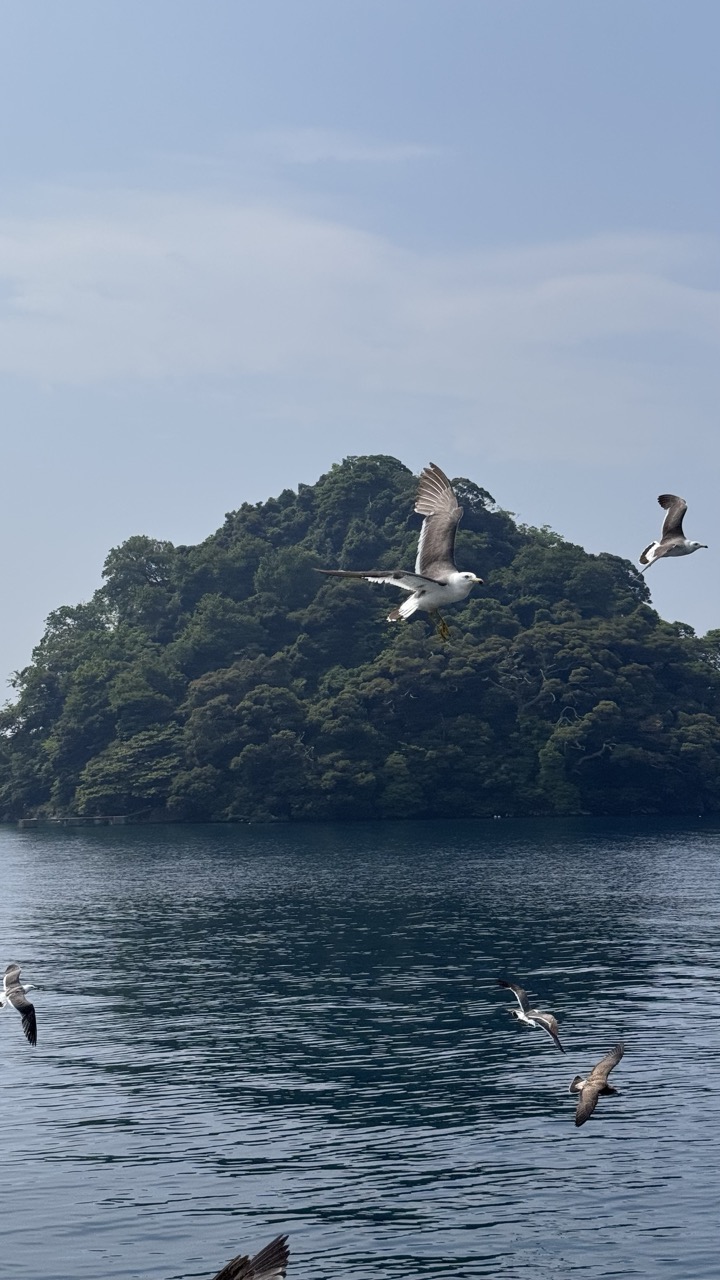

1. Overall Rating (0–10) — 7.0
This photograph captures a serene coastal scene, where the dynamic movement of seagulls contrasts beautifully with the stillness of the water and the lush green island in the background. The natural lighting enhances the sense of calm, while the birds in flight inject energy and life into the composition. While the image is visually engaging and well-balanced, it remains somewhat conventional in its execution, lacking a stronger emotional hook or compositional boldness to elevate it beyond a pleasant snapshot.
2. Composition (0–10) — 7.5
The island is centered and grounded, creating a stable focal point, while the scattered seagulls add dynamic motion across the frame. The lower third of the image is slightly underutilized, but the diagonal flight paths of the birds create a sense of movement that guides the eye through the scene.
3. Lighting (0–10) — 8.0
Natural daylight bathes the scene in soft, even light, highlighting the texture of the trees and the gentle ripples on the water. The sky is bright but not overexposed, allowing for a balanced exposure that enhances the tranquil mood.
4. Color & Tone (0–10) — 7.5
The palette is harmonious, with deep greens of the island contrasting against the cool blues of the water and sky. The muted tones of the seagulls provide subtle variation, and the overall tonal range is well-distributed, contributing to a calm and cohesive aesthetic.
5. Creativity (0–10) — 6.5
While the subject matter is familiar—birds over water—the composition and timing capture a moment of quiet energy. The image leans more toward observational beauty than conceptual innovation, but the interplay of movement and stillness offers a thoughtful visual narrative.
6. Technical Quality (0–10) — 8.0
The image is sharp and clear, with well-defined details in both the birds and the foliage. The focus is consistent across the frame, and there is minimal noise or distortion, indicating strong technical execution.
7. Emotional Impact (0–10) — 7.0
The photograph evokes a sense of peace and connection with nature, enhanced by the motion of the birds suggesting freedom and wildness. It invites quiet contemplation and feels like a fleeting moment captured in time, resonating with viewers who appreciate natural beauty and tranquility.
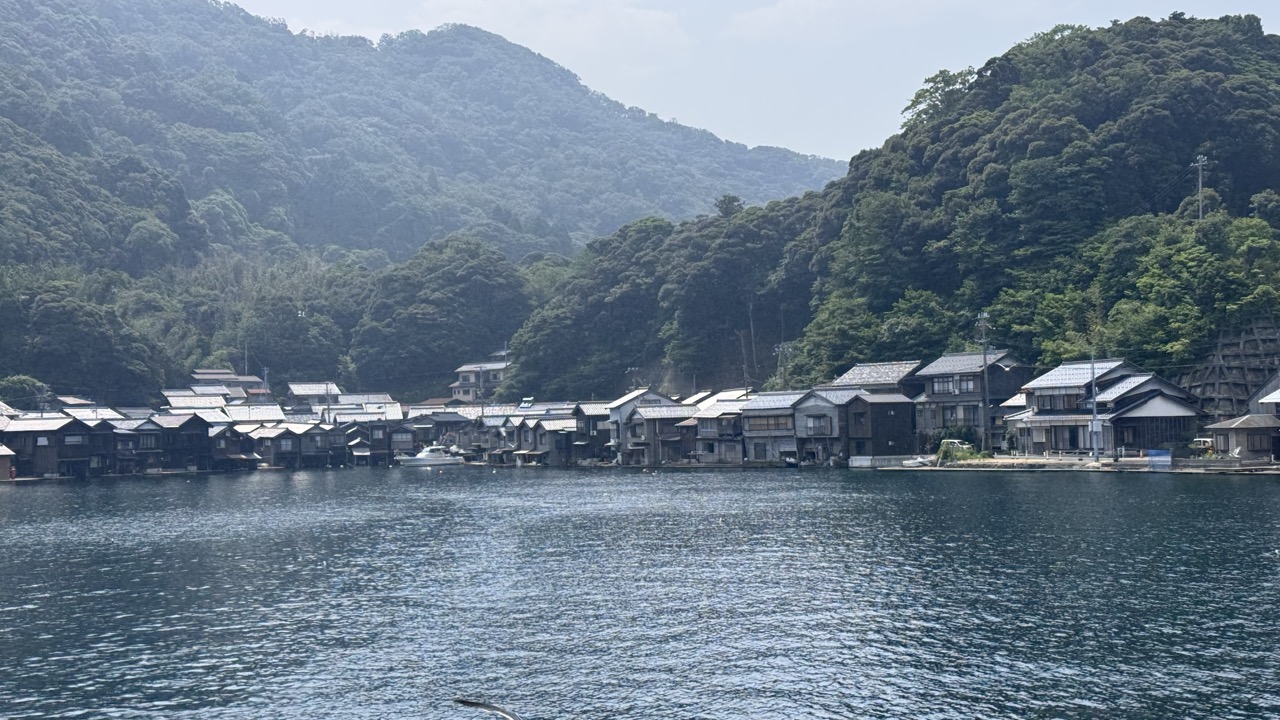

1. Overall Rating (0–10) — 7.0
This photograph captures the serene harmony of a traditional lakeside village nestled between lush, forested hills, evoking a sense of timeless tranquility. The composition balances the calm water in the foreground with the clustered homes and the imposing natural backdrop, creating a peaceful, almost meditative atmosphere. While the image is visually pleasing, its subdued lighting and lack of dynamic contrast slightly diminish its emotional punch, leaving it feeling more like a snapshot than a deeply resonant moment.
2. Composition (0–10) — 7.5
The scene is well-balanced, with the row of houses forming a strong horizontal line that guides the eye across the frame. The framing includes a generous amount of water in the foreground and hills in the background, creating depth and context. The slight asymmetry adds visual interest without disrupting harmony.
3. Lighting (0–10) — 6.0
The lighting is soft and diffused, likely due to an overcast sky or haze, which flattens the scene and reduces the richness of textures. While this creates a calm, even tone, it also limits the contrast and depth that could have made the image more striking.
4. Color & Tone (0–10) — 6.5
The palette is dominated by cool blues and greens, with muted earth tones in the buildings, creating a cohesive and naturalistic look. However, the lack of vibrant color or strong tonal contrast gives the image a slightly washed-out quality, reducing its visual impact.
5. Creativity (0–10) — 6.5
The photograph presents a familiar scenic view with a clear sense of place, but it lacks a unique perspective or interpretive twist. It captures the essence of the location effectively but does not push creative boundaries or invite deeper interpretation.
6. Technical Quality (0–10) — 7.5
The image is sharp and clear, with good detail in both the water and the structures. The focus is consistent across the midground, and there are no apparent technical flaws such as blur or noise.
7. Emotional Impact (0–10) — 6.0
The image evokes a quiet sense of peace and stillness, appealing to those drawn to natural and cultural landscapes. However, the lack of strong emotional cues or human presence keeps the viewer at a distance, making the connection more intellectual than visceral.
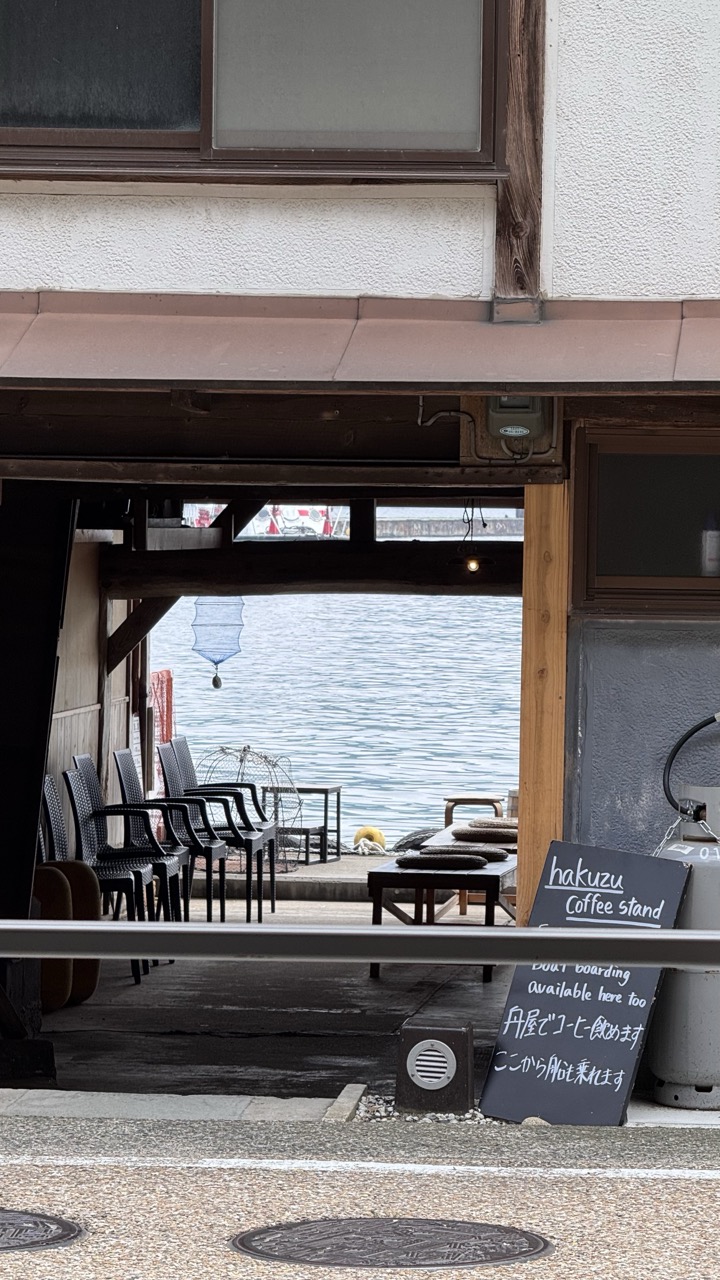

1. Overall Rating (0–10) — 7.0
This photograph captures a quiet, contemplative moment at a coastal coffee stand, where the stillness of the water mirrors the calm rhythm of daily life. The framing through the wooden archway creates a natural vignette, drawing the eye to the serene seascape beyond, while the handwritten sign and modest setup lend authenticity. Though the image is grounded in realism, its subtle composition and muted tones evoke a sense of peaceful solitude that feels both intimate and universal.
2. Composition (0–10) — 7.0
The archway acts as a strong leading frame, guiding the viewer’s gaze into the scene. The placement of the sign and chairs adds depth and balance, though the foreground railing slightly interrupts the visual flow.
3. Lighting (0–10) — 6.5
Soft, diffused daylight evenly illuminates the scene, creating a calm, natural atmosphere. The lack of harsh shadows enhances the tranquil mood, though a touch of directional light might have added more dimension.
4. Color & Tone (0–10) — 6.5
The palette is subdued, dominated by muted grays, browns, and soft blues, which reinforces the quiet, contemplative tone. The limited color range works well, but a slightly richer blue in the water could enhance visual interest.
5. Creativity (0–10) — 7.0
The image leverages a simple, everyday setting with thoughtful framing to create a narrative of stillness and connection to place. The inclusion of both English and Japanese text adds cultural texture and invites the viewer into a specific moment.
6. Technical Quality (0–10) — 7.5
Sharp focus and clean detail are evident throughout, with a well-balanced exposure that preserves detail in both the foreground and background. The depth of field is appropriate, keeping the main elements clear.
7. Emotional Impact (0–10) — 7.0
The photograph evokes a quiet sense of peace and reflection, inviting the viewer to pause and imagine themselves in the scene—perhaps sipping coffee while watching the water. It captures a fleeting moment of stillness that resonates with a universal longing for calm.
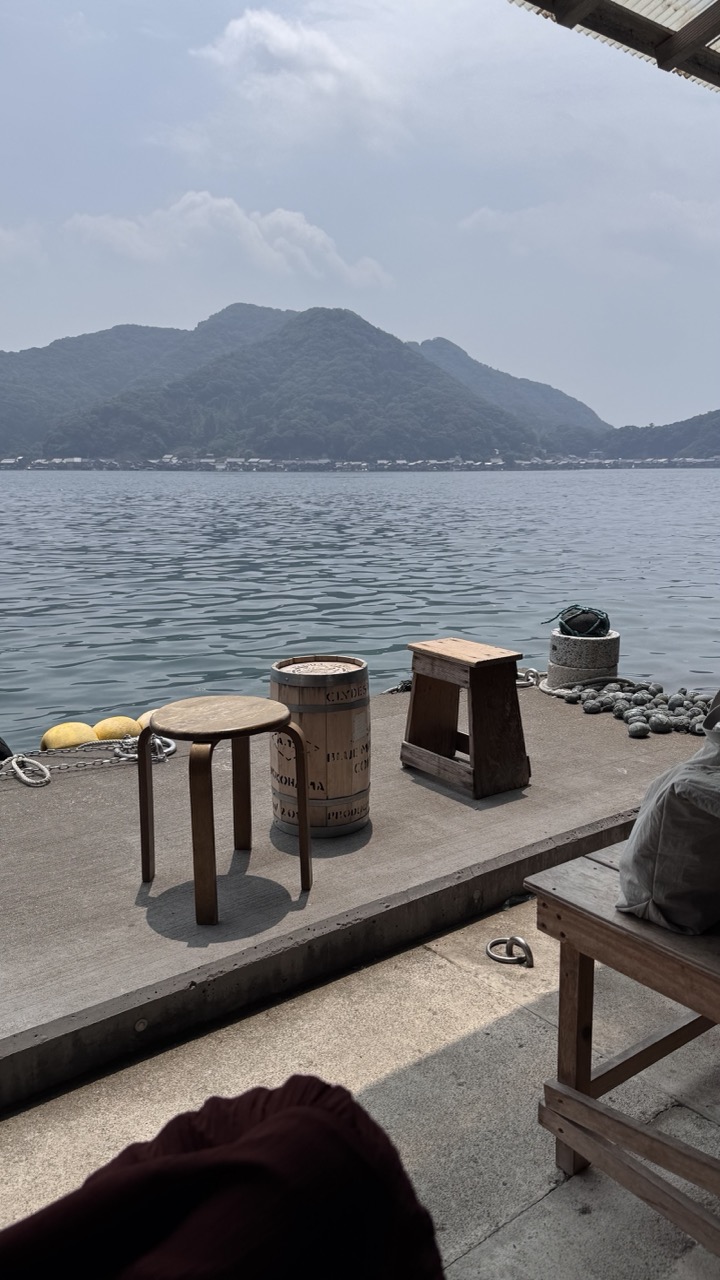

1. Overall Rating (0–10) — 7.0
This photograph captures a serene, contemplative moment at a quiet waterfront, where the stillness of the water and the soft haze over the mountains evoke a sense of calm introspection. The composition, though modest in its arrangement, successfully frames a quiet corner of daily life—where human-made objects like stools and a barrel sit in harmony with the natural landscape. While the image lacks dramatic lighting or bold color, its strength lies in its understated authenticity and the subtle narrative of stillness and solitude.
2. Composition (0–10) — 6.5
The frame is anchored by the foreground objects—stools, a barrel, and a bench—creating a layered depth that draws the eye toward the distant mountains. The low-angle perspective enhances the sense of presence, as if the viewer is seated on the dock. However, the slight clutter of the foreground elements and the inclusion of the person’s leg at the bottom edge slightly disrupt the visual balance.
3. Lighting (0–10) — 6.0
The lighting is soft and diffused, likely due to an overcast sky, which mutes the contrast and gives the scene a muted, tranquil quality. While this enhances the mood of quiet contemplation, it also flattens the tonal range and reduces the visual drama of the landscape.
4. Color & Tone (0–10) — 6.5
The palette is restrained, dominated by cool grays and blues in the water and sky, with earthy browns and muted wood tones in the foreground. This limited color scheme supports the peaceful, contemplative mood, though a touch more saturation or warmth could have added subtle vibrancy without disrupting the atmosphere.
5. Creativity (0–10) — 7.0
The image succeeds in conveying a quiet, personal moment rather than a grand landscape. The inclusion of everyday objects and the human element (the leg) adds a narrative layer, transforming a simple view into a story of pause and reflection. It’s a thoughtful, observational approach that values mood over spectacle.
6. Technical Quality (0–10) — 7.5
The image is sharp and clear, with good detail in the foreground objects and a well-defined horizon. The focus is consistent across the frame, and the exposure is balanced, capturing both the bright sky and the darker elements of the dock without significant loss of detail.
7. Emotional Impact (0–10) — 7.0
There’s a strong sense of peace and quiet contemplation, evoked by the still water, the distant mountains, and the unoccupied, waiting space on the dock. The viewer is invited to sit, pause, and absorb the moment—though the emotional resonance is subtle and introspective rather than overwhelming.
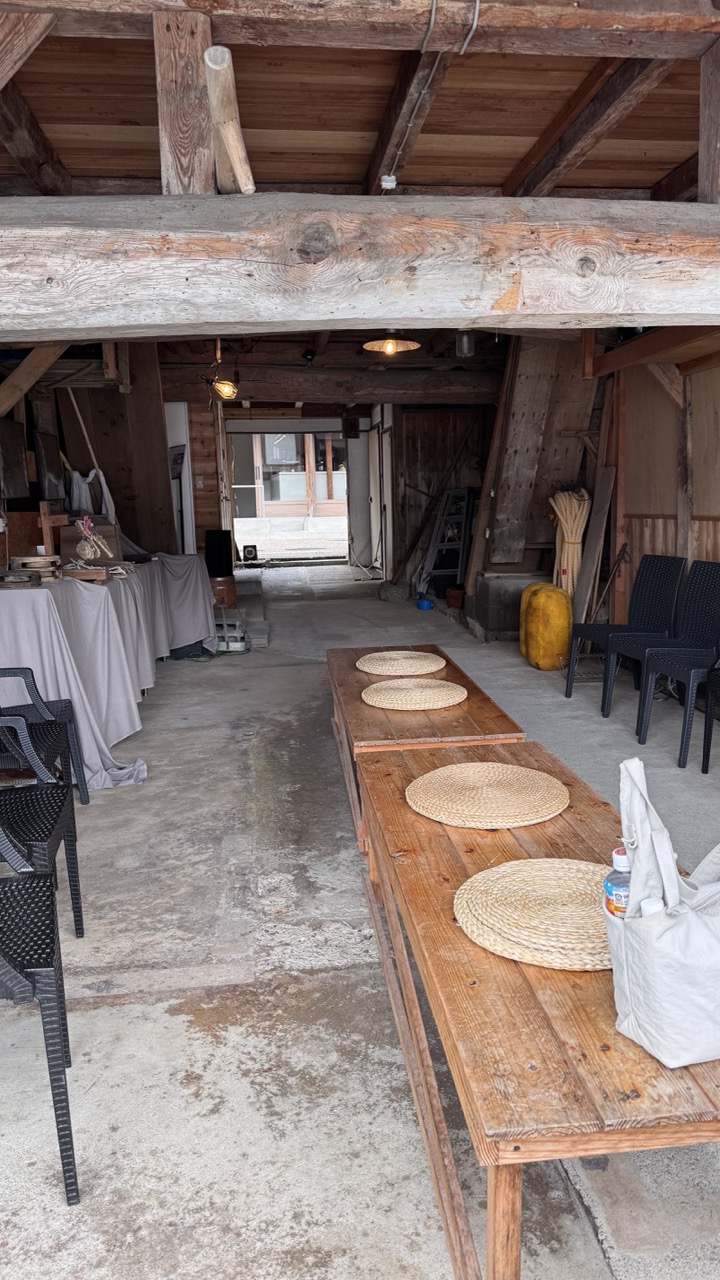

1. Overall Rating (0–10) — 6.0
This photograph captures the quiet, lived-in atmosphere of a rustic wooden space, where the weight of time and use is visible in every grain and crack. The composition draws the eye through the depth of the room, inviting contemplation of its history and function, though the clutter and uneven lighting slightly undermine its visual cohesion. While the scene feels authentic and grounded, it lacks the polish and deliberate framing needed to elevate it into a more compelling visual narrative.
2. Composition (0–10) — 6.5
The long perspective creates a strong sense of depth, with the wooden table and placemats leading the eye toward the doorway. The overhead beam frames the top of the image effectively, but the left side feels slightly unbalanced due to the cluttered table and scattered objects.
3. Lighting (0–10) — 5.5
Natural light from the doorway provides a soft, directional glow, but the interior is underlit and reliant on artificial sources that cast a warm, uneven tone. The lack of dynamic lighting limits the mood and texture.
4. Color & Tone (0–10) — 5.0
The palette is dominated by muted earth tones—browns, grays, and beige—which reinforce the rustic feel but lack vibrancy. The tonal range is narrow, with little contrast between highlights and shadows, giving the image a flat appearance.
5. Creativity (0–10) — 6.0
The image captures a genuine moment of everyday life in a traditional setting, with an emphasis on texture and authenticity. While not highly stylized, it succeeds in conveying a sense of place and cultural context.
6. Technical Quality (0–10) — 7.0
The focus is sharp on the foreground table and placemats, and the image is free of technical flaws. The slight grain and softness in the background suggest a natural, unedited aesthetic that suits the subject.
7. Emotional Impact (0–10) — 5.5
The photograph evokes a sense of calm and nostalgia, but the lack of strong emotional cues or human presence keeps the viewer at a distance. It feels more like a document than an emotional experience.
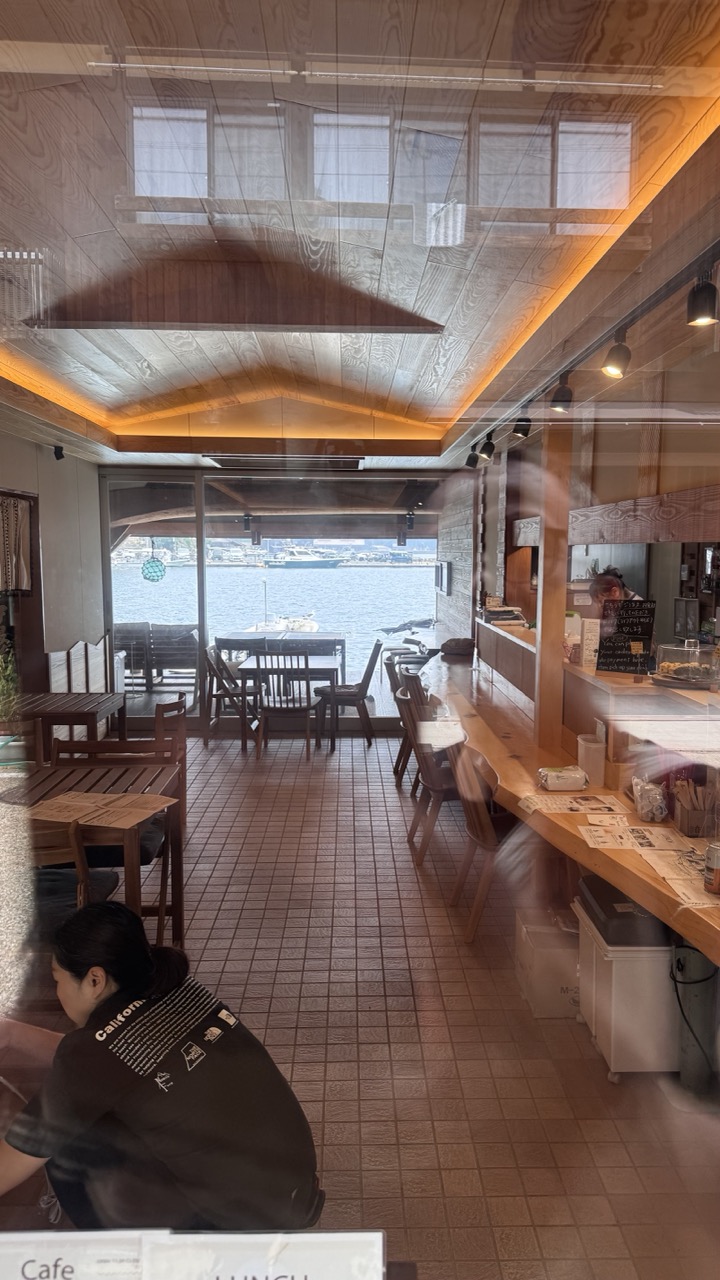

1. Overall Rating (0–10) — 6.8
This photograph captures a serene, introspective moment inside a waterfront café, where the quiet hum of daily life blends with the stillness of the water beyond. The layered reflections on the glass add a dreamlike quality, suggesting a fleeting glimpse into a peaceful, everyday ritual. While the image is visually rich with texture and atmosphere, the slight blur and overexposed reflections detract from its overall clarity and emotional depth.
2. Composition (0–10) — 6.5
The long perspective draws the eye through the café toward the water, creating a sense of depth and narrative. However, the reflection in the glass disrupts the visual flow, and the foreground figure slightly obstructs the view, creating a sense of imbalance.
3. Lighting (0–10) — 6.0
Natural light floods in from the large windows, creating a warm and inviting glow, especially along the wooden ceiling. However, the strong reflections on the glass reduce contrast and obscure details, while the interior lighting appears uneven, with some areas underexposed.
4. Color & Tone (0–10) — 6.5
The warm wooden tones and earthy floor tiles create a harmonious palette that complements the tranquil setting. The cool blue of the water provides a gentle contrast, but the overall color balance is slightly muted, with reflections washing out the vibrancy of the scene.
5. Creativity (0–10) — 7.0
The use of reflection introduces a layer of visual complexity, transforming a simple café interior into a contemplative, almost abstract composition. The interplay between the real and the reflected world adds a poetic quality, suggesting themes of memory and perception.
6. Technical Quality (0–10) — 6.0
The image exhibits soft focus and slight motion blur, likely due to the reflective surface and ambient light. While the details of the café are discernible, the lack of sharpness and the glare reduce the overall technical precision.
7. Emotional Impact (0–10) — 7.0
There’s a quiet intimacy in the image, evoking a sense of calm and solitude. The viewer is invited to pause and reflect, as if standing just outside the café, watching life unfold in a moment suspended between stillness and movement.
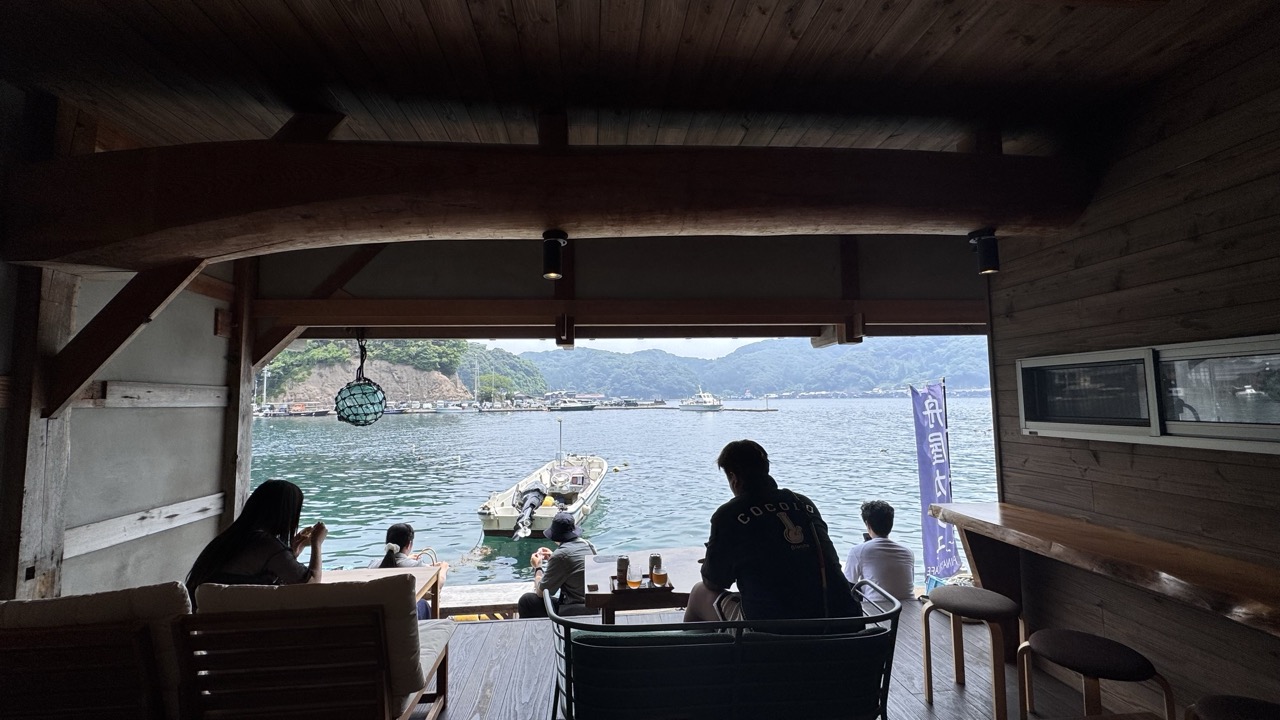

1. Overall Rating (0–10) — 7.0
This photograph captures a serene, contemplative moment at a waterfront café, where the quiet stillness of a harbor blends with the subtle human presence of patrons enjoying the view. The deep interior shadows contrast beautifully with the bright, open water and distant hills, creating a sense of sheltered intimacy. While the image effectively conveys atmosphere, its slightly flat lighting and unbalanced composition hold it back from greater visual impact.
2. Composition (0–10) — 6.0
The wide frame and off-center placement of the people create a sense of candid observation, but the heavy wooden beams and uneven foreground distract from the natural flow toward the water. A tighter crop would better focus attention on the interaction between the subjects and the landscape.
3. Lighting (0–10) — 6.5
The natural daylight from the open front illuminates the harbor and mountains, but the interior remains in deep shadow, reducing detail and contrast. The lighting feels realistic and unmanipulated, but lacks the dynamic range needed to highlight texture and depth.
4. Color & Tone (0–10) — 6.5
The palette is dominated by cool blues and muted earth tones, reflecting the coastal environment. While cohesive, the colors lack vibrancy and warmth, giving the scene a slightly subdued, overcast quality.
5. Creativity (0–10) — 7.0
The photograph succeeds in capturing a quiet, lived-in moment, using the architecture and framing to create a sense of place. The inclusion of the fishing boat and banner adds narrative depth, suggesting a local, authentic setting.
6. Technical Quality (0–10) — 7.5
The image is sharp and well-focused, with clean details in the wooden structure and water. The exposure is balanced, though the darker interior areas lose some detail, a trade-off for preserving highlights in the exterior.
7. Emotional Impact (0–10) — 7.0
The image evokes a sense of calm and reflection, inviting the viewer to pause and take in the view. The silhouetted figures add a human element, making the scene feel both peaceful and relatable.
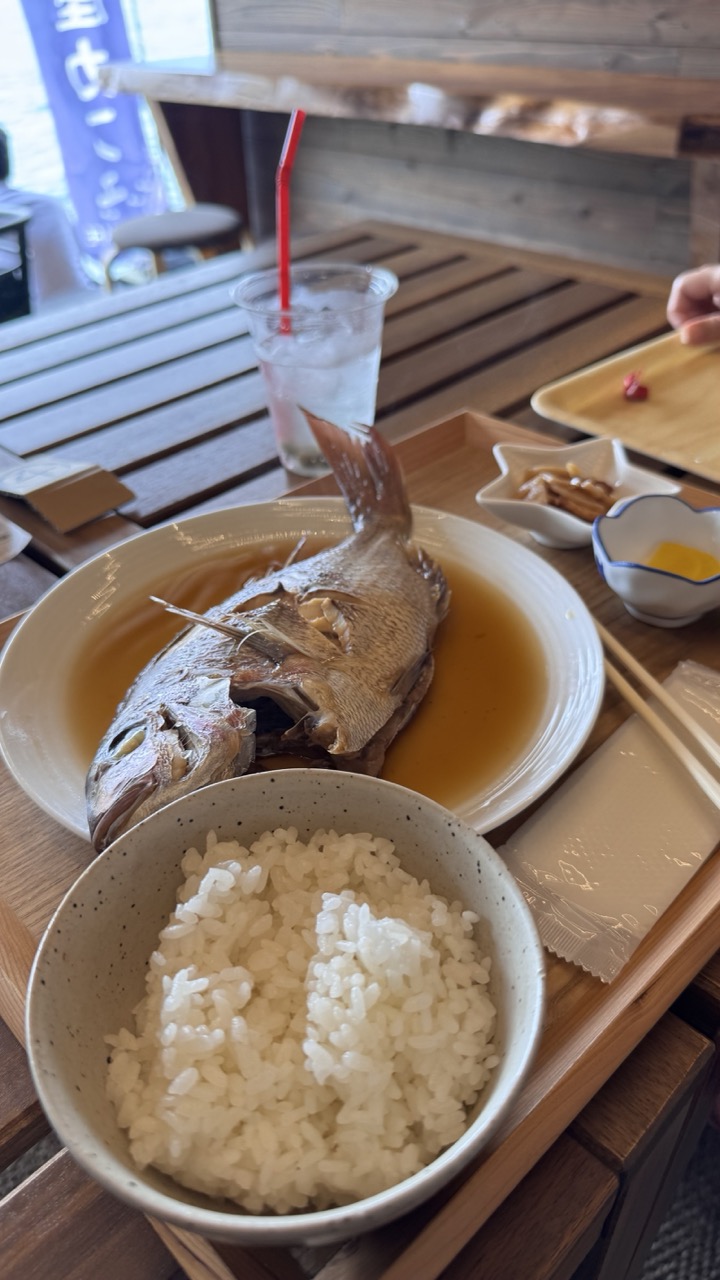

1. Overall Rating (0–10) — 6.8
This photograph captures a tranquil moment of a traditional Japanese meal, where the simplicity of a steamed fish and rice evokes a sense of calm and authenticity. The natural textures of the wooden table and ceramicware enhance the rustic charm, while the soft daylight infuses the scene with quiet warmth. Though the composition feels slightly candid and unpolished, it succeeds in conveying a genuine, unposed dining experience—more documentary than staged, yet still visually engaging.
2. Composition (0–10) — 6.5
The diagonal placement of the fish and rice creates a natural visual flow, drawing the eye from the foreground to the background. However, the cluttered arrangement of small dishes and the partial view of a hand slightly distract from the central subject, reducing compositional harmony.
3. Lighting (0–10) — 7.0
Soft, diffused daylight illuminates the scene evenly, enhancing the natural textures of the food and wood. The gentle shadows add depth without overpowering the details, creating a warm and inviting atmosphere.
4. Color & Tone (0–10) — 6.5
The palette is restrained and natural, dominated by earthy beiges, whites, and the golden hue of the broth. While harmonious, the colors lack vibrancy, giving the image a slightly muted and flat quality that limits visual excitement.
5. Creativity (0–10) — 6.0
The image celebrates everyday authenticity, capturing a simple meal with quiet dignity. While not overtly artistic, it reflects a thoughtful approach to documenting cultural food traditions, offering a slice of life rather than a stylized interpretation.
6. Technical Quality (0–10) — 7.5
The focus is sharp on the foreground elements—especially the rice and fish—with a clean depth of field that softly blurs the background. The image is well-exposed and free of distracting noise, showcasing good technical control.
7. Emotional Impact (0–10) — 7.0
There’s a quiet intimacy in the scene that resonates with comfort and contentment. The viewer is invited to savor not just the meal, but the stillness of the moment—evoking a sense of peace and appreciation for simple pleasures.
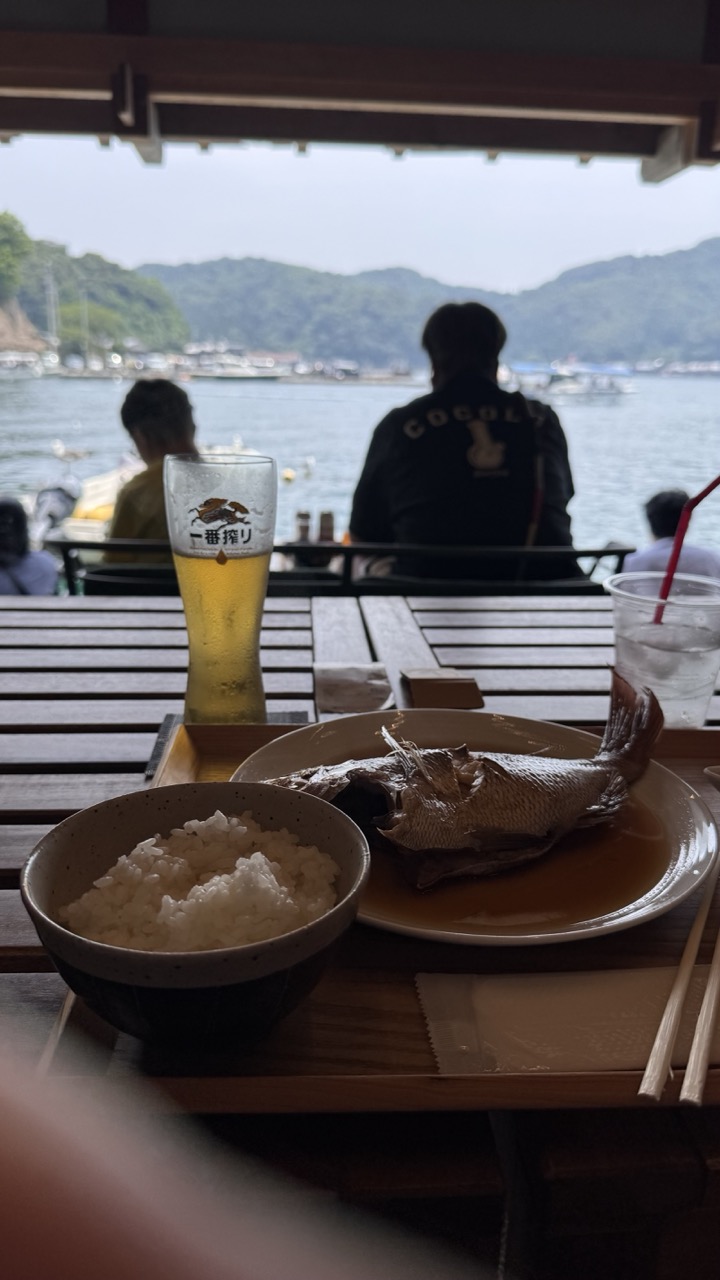

1. Overall Rating (0–10) — 6.0
This photograph captures a quiet, contemplative moment at a waterside dining spot, where the simple meal of grilled fish and rice is framed by a serene view of hills and boats. The composition balances foreground and background well, evoking a sense of place and stillness, though the flat lighting and muted colors slightly dampen the emotional resonance. It feels like a candid snapshot of travel—a memory preserved rather than a polished image—but its authenticity gives it quiet charm.
2. Composition (0–10) — 7.0
The meal in the foreground anchors the image, with the glass of beer and rice bowl creating a strong visual base. The seated figures and distant harbor draw the eye into the background, offering depth and context. The wooden table and overhang frame the scene naturally, guiding the viewer’s gaze toward the landscape.
3. Lighting (0–10) — 5.5
The lighting is soft and diffused, typical of an overcast day, which creates even exposure but diminishes contrast and shadows. The lack of directional light gives the image a flat quality, though it suits the calm, subdued mood of the setting.
4. Color & Tone (0–10) — 5.0
The palette is dominated by muted grays and earthy browns, with the pale yellow of the beer offering a subtle pop. The overall tone is subdued and naturalistic, reflecting the quiet atmosphere but lacking vibrancy or dynamic contrast.
5. Creativity (0–10) — 6.5
The image succeeds in capturing a moment of everyday beauty rather than staging a dramatic scene. The juxtaposition of a simple meal with a scenic backdrop suggests a narrative of travel and quiet enjoyment, offering a personal, immersive perspective.
6. Technical Quality (0–10) — 7.5
The focus is sharp on the foreground elements—especially the glass and fish—while the background remains softly blurred, indicating good depth of field control. The image is clean and free of noise, with natural detail visible in the textures of the food and wood.
7. Emotional Impact (0–10) — 6.0
There’s a gentle warmth in the scene, evoking feelings of peace, solitude, and contentment. The viewer is invited to imagine sitting there, sipping beer and watching the water—though the slightly distant perspective keeps the emotional connection just shy of deeply personal.
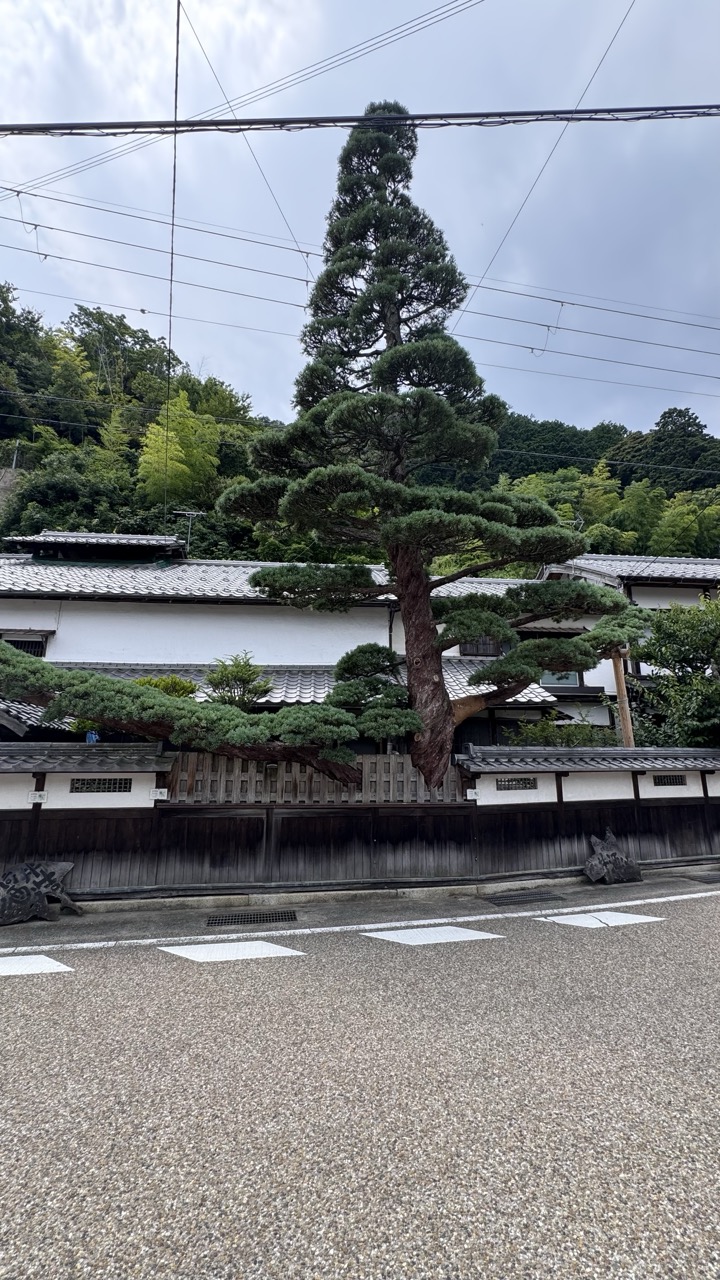

1. Overall Rating (0–10) — 6.0
This photograph captures a quiet, contemplative moment in a traditional Japanese streetscape, where nature and architecture coexist in subtle harmony. The sculpted pine tree stands as a striking focal point, its form echoing the restrained elegance of the surrounding structures. However, the intrusion of overhead power lines disrupts the visual serenity, and the overcast sky lends a muted tone that softens the scene’s potential impact. While the image succeeds in documenting a slice of cultural landscape, it stops short of evoking deeper emotional resonance.
2. Composition (0–10) — 6.5
The tree is well-centered and dominates the frame, drawing the eye upward through its layered branches. The low angle emphasizes its height and form, while the horizontal lines of the wall and road anchor the composition. The framing includes a slight imbalance due to the power lines crossing the upper third, which interrupts the visual flow.
3. Lighting (0–10) — 5.0
The diffused light from the overcast sky creates soft, even illumination with minimal shadows, which flattens the image’s depth. While this prevents harsh contrasts, it also diminishes the texture and dimensionality of the tree and buildings, resulting in a subdued and somewhat lifeless atmosphere.
4. Color & Tone (0–10) — 5.5
The palette is restrained—dominated by muted greens, grays, and earthy browns—reflecting the natural and architectural tones of the setting. The lack of vibrant color contributes to a somber mood, and the tonal range is narrow, with little contrast between light and dark areas.
5. Creativity (0–10) — 6.0
The image is conceptually grounded in the juxtaposition of nature and tradition, with the carefully shaped pine tree symbolizing patience and cultivation. However, the composition remains largely observational rather than expressive, lacking a strong narrative or artistic intervention to elevate it beyond documentation.
6. Technical Quality (0–10) — 7.5
The focus is sharp across the frame, and the image is free of noticeable noise or blur. The resolution is adequate, and the details in the tree’s foliage and the wooden fence are clearly rendered, indicating strong technical execution.
7. Emotional Impact (0–10) — 5.5
The photograph evokes a sense of calm and stillness, but the emotional connection is tempered by the visual clutter of the power lines and the lack of dynamic lighting. It invites reflection on tradition and time, but does not deeply stir the viewer.
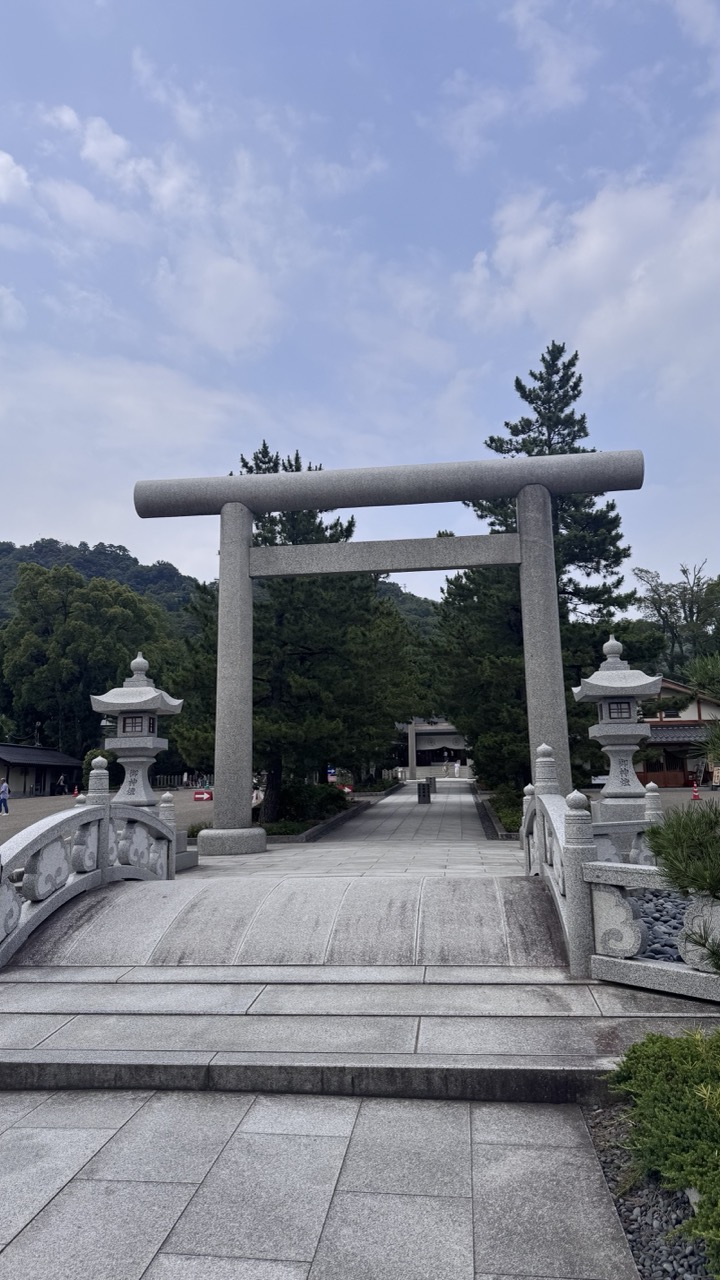

1. Overall Rating (0–10) — 7.5
This photograph captures the serene grandeur of a traditional Japanese shrine, where the towering torii gate stands as a threshold between the mundane and the sacred. The symmetrical composition and expansive perspective draw the eye forward, evoking a sense of reverence and stillness. While the image is grounded in authenticity and tranquility, its restrained color palette and slightly overcast light temper its visual impact, leaving room for more dramatic atmosphere.
2. Composition (0–10) — 8.0
The centered framing and strong leading lines of the stone pathway guide the viewer’s gaze toward the torii and beyond, creating a sense of depth and intention. The balance between the gate, lanterns, and surrounding greenery enhances harmony and visual order.
3. Lighting (0–10) — 6.5
Soft, diffused daylight evenly illuminates the scene, preserving detail in the stone textures without harsh shadows. However, the overcast sky lends a muted quality to the light, reducing contrast and atmospheric drama.
4. Color & Tone (0–10) — 6.0
The palette is dominated by cool grays and soft greens, creating a cohesive and tranquil mood. While harmonious, the lack of vibrant color limits the image’s emotional resonance and visual pop.
5. Creativity (0–10) — 7.0
The photograph successfully captures a moment of quiet spiritual transition, using traditional elements to evoke cultural and emotional depth. The composition is thoughtful, but the approach remains more documentary than expressive.
6. Technical Quality (0–10) — 8.5
Sharp focus and clear detail are evident throughout, particularly in the textures of the stone and the clean lines of the architecture. The exposure is well-balanced, with no blown highlights or crushed shadows.
7. Emotional Impact (0–10) — 7.0
The image conveys a peaceful, contemplative mood, inviting the viewer to pause and reflect. The scale of the torii and the quiet setting evoke a sense of reverence, though the lack of human presence slightly distances the emotional connection.


1. Overall Rating (0–10) — 7.0
This photograph captures a serene moment of human presence within a vast natural landscape, where the blue bridge acts as a visual anchor between land and water. The composition balances the weight of the tree on the left with the expansive sky and hills, creating a sense of calm harmony. While the image is visually grounded and well-framed, it lacks a strong emotional punch, feeling more like a pleasant snapshot than a compelling narrative.
2. Composition (0–10) — 7.5
The bridge cuts diagonally across the frame, guiding the eye from the foreground tree to the distant hills. The placement of people along the bridge adds scale and life, while the left-leaning tree provides visual weight and balance. The shallow depth of field keeps the midground sharp, enhancing the sense of space.
3. Lighting (0–10) — 7.0
Natural daylight illuminates the scene evenly, with soft, diffused light that enhances the tranquil mood. The overcast sky prevents harsh shadows, allowing details in both the water and foliage to remain clear and visible.
4. Color & Tone (0–10) — 7.0
The palette is dominated by cool blues and greens, creating a cohesive and calming atmosphere. The blue of the bridge harmonizes with the water and sky, while the green of the tree and hills adds depth. The tones are well-balanced, though slightly muted, giving the image a subtle, understated quality.
5. Creativity (0–10) — 6.5
The image is composed with intention, using natural elements and human figures to create a balanced, narrative-rich scene. While the concept is familiar, the way the bridge connects the elements adds a quiet poetic quality, suggesting movement and connection across time and space.
6. Technical Quality (0–10) — 8.0
The image is sharp and clear, with precise focus on the bridge and the figures. The camera settings appear well-chosen, capturing fine details in the water’s surface and the texture of the tree bark. There is minimal noise, and the exposure is well-managed.
7. Emotional Impact (0–10) — 6.5
The photograph evokes a sense of peace and contemplation, inviting the viewer to imagine crossing the bridge and stepping into the quiet beauty of the landscape. The presence of people adds a human touch, but the overall mood remains detached and reflective, leaving room for personal interpretation.
Loading map...